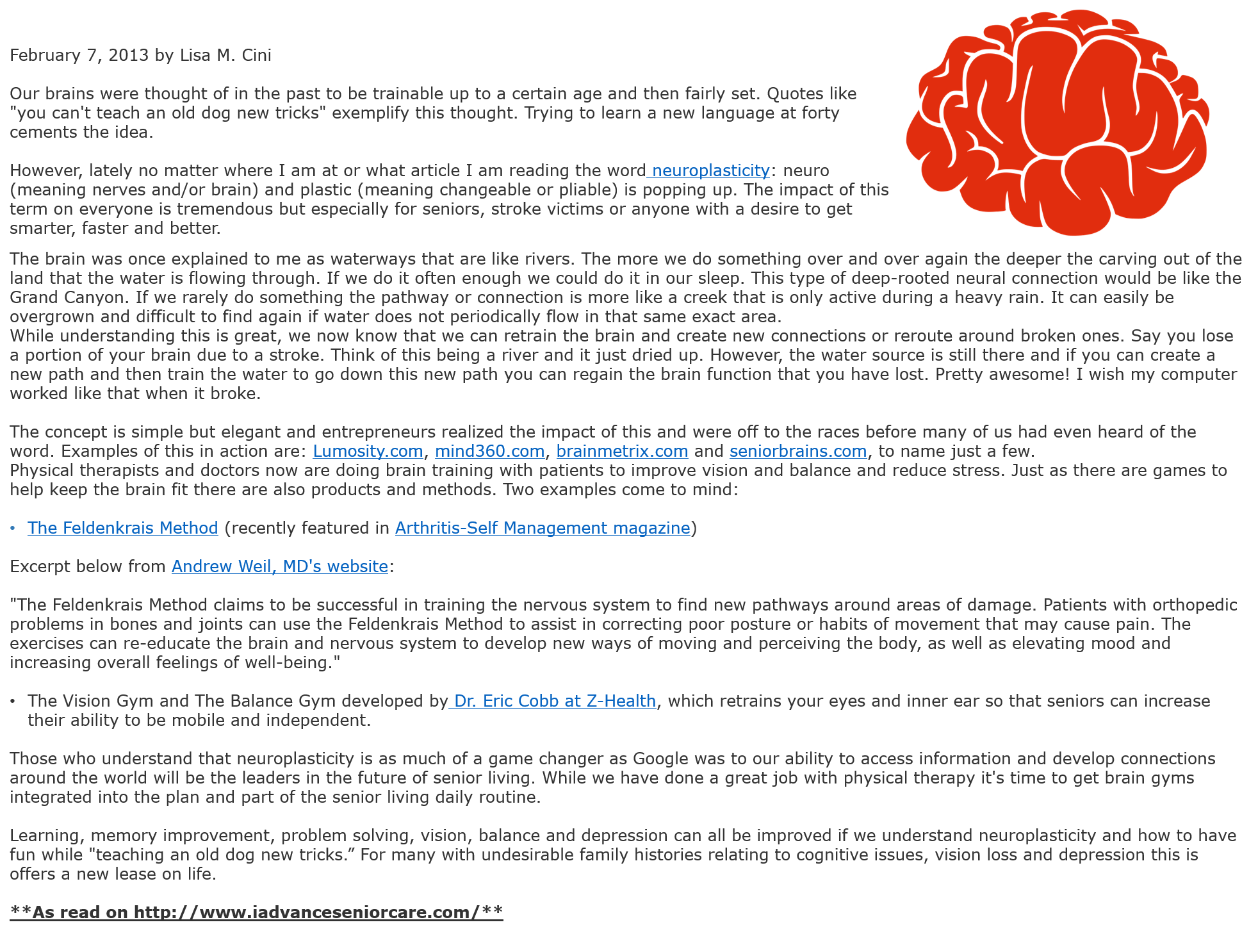Don’t Spend Money on That!

When we think about how much we spend, we all want three things: high quality, beautiful aesthetics, and low cost. Unfortunately for all of us, sacrifices must be made. As you are building your budget, we’ve already given you some tips (see our last blog - Senior Living: The Top 5 Mistakes When Budgeting for a Renovation or New Build) mistakes we see most often that can leave you with costs well over what you originally planned. This time around, we are going to talk about the places in your budget where you are probably spending too much money and how to redirect that money to things that really matter. Let’s talk about a couple of places where you can cut some of your budget and where you should allocate that money.
Back of House – Pay for Quality, Cut the Aesthetics
Your employees are going to need equipment and furniture that is sturdy, long lasting, and dependable no matter what it goes through. You don’t need to spend money on the aesthetics of a space that won’t be available to your residents. It’s like buying a computer: you don’t spend money on a computer because it looks amazing, you spend money on it because it works and is the best bang for your buck. In this instance, save some money and make sure that even if it isn’t as aesthetically pleasing, it works when it is supposed to and lasts. Your employees will appreciate having functional quality over a pretty desk that doesn’t support their needs.
(NOTE: An exception to this would be a nice break room. Give your employees somewhere they can relax that has some aesthetic qualities to let them decompress and show them how much you care for them. Front of house offices like marketing, ED, and the business office should also be nice as they meet directly with residents and families. )
Resident Rooms – Make It Comfortable and Functional
If you build your space in a way that encourages socialization, your residents shouldn’t be spending all their time in their private rooms. Resident rooms should be for personal care, eating, sleeping, changing, etc. That means you don’t need the same commercially durable floors and furniture that you would need in the rest of the home where the caregiving team and all the residents are utilizing the space. You don’t buy a heavy winter coat when you live in Florida. Make sure the room is comfortable and functional, spending money on the fixtures, excellent closets, countertops, right height outlets and the windows. Cut extra details like window and door trim, large base and crown molding. With the money you save, you can allocate some extra funds to our next space, the common areas.
Common Areas – The Money Maker
Common areas are where you set the tone for your living space. We mentioned it earlier, but prioritizing socialization in your space means creating warm and inviting common areas where residents and families can get together. You want these spaces to be beautiful and durable. They should be purposeful and engaging. Common areas are your public parks and great downtown areas where you want to attract people and give them a space to connect, learn and have fun. This is where you put that money you saved in your other two spaces to get the most value out of your budget. Include special items that will benefit the community and make it a place that is so magnetic it draws folks to connect. It could be incredible design elements, technology, furniture, lighting or excellent indoor/outdoor space. You want to invest in the people that are going to make this their home. So put that money where it is going to give the most to your residents and their families!
The Goldilocks principle
Bigger is not always better, but sometimes smaller can make a space not work at all. When it comes to space planning the Interior Designer has to drive the process vs the architect. A space needs to be JUST RIGHT… Space planning needs to have correct sized furniture pieces on the plans as well as circulation plans denoted in order to ensure the space works for the intended use. We have all seen some spaces so large that it’s uncomfortable to sit in them as you feel you’re on display or can’t hear others properly. We have also seen resident units where the kitchen was so large that there was literally no room to have more than a chair to watch tv. These are costly mistakes that we see happening over and over again when designers are brought in too late. It’s super cheap to get a plan looked at by a designer at the beginning of your design project and can not only save construction costs but increase the ability to market.
What Else Should I Avoid?
Mosaic can help you with that. We have a variety of ways to make sure you are spending money where it counts. Whether you would like a consult to discuss your design needs or a full Cornerstone Assessment where we take you through a fully itemized budget detail so you know exactly what your options are and howmuch they will cost, Mosaic can bring you the confidence and wisdom that you are going to get the space you want with the least amount of hassle and cost.
Senior Living: The Top 5 Mistakes When Budgeting for a Renovation or New Build
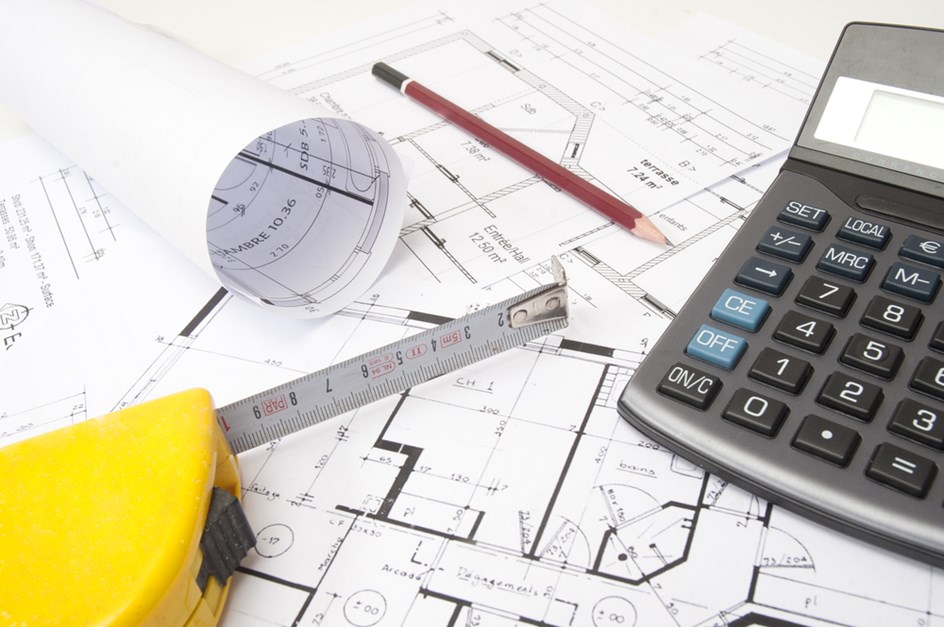
Whether you are building a brand-new space or renovating an older one, your budget is the most important part of getting started. Without a proper budget, you are likely going to have to make VE cuts (VE=value engineering, which really means you’re over budget and now you have to cut items) so that you don’t end up with a white box that looks more like an office than a resort.
Creating the correct budget takes work and attention to detail. There is a lot of pricing to consider such as: construction costs, design fees, furniture, finishes, window treatments, artwork, accessories, smallware’s, exterior furniture, signage and Low voltage items. Understanding the TOTAL cost of your space is going to help you make the best decisions by being proactive vs having to make them in a crisis situation. You know the ole Benjamin Franklin saying, “If you fail to plan, you are planning to fail.” Wise spending requires excellent financial intel that a holistic budget can provide. This will get you to market faster, keep you on budget without having to make excessive VE cuts or having to go back to your investors and ask for more money.
To help you get started, here are the top 5 mistakes we’ve seen folks make when their budgets don’t match their dream:
Small Costs…Cost More
There is a big difference between budgeting for one room vs. planning for many rooms. When you are budgeting for one room, costs are generally higher than when you build in bulk. Think of it like driving a car. When you drive short distances in the city, you get terrible gas mileage. When you are traveling longer distances on the highway, you get great gas mileage. Small renovations still require the same prep time and stop time, it’s just like starting and stopping when city driving. With a larger space, you get to take advantages of economies of scale so just like highway driving, the price per mile is better when you have farther (bigger) to go. When you hire a painter, you don’t get the same price per room for one room as you would for ten rooms. You have to keep that pricing in mind when budgeting for smaller renovations or your wallet may be in peril.
Not All Spaces Are Created Equal
Location, location, location. Where you are making changes to a design or expanding spaces, the location of the change makes a huge difference. Many contractors will show you an average price per square foot (sq. ft.) when they calculate their total cost. But, per sq. ft., common areas (dining rooms, lounge, lobby, fitness rooms, etc.) cost more than resident rooms which cost more than hallways. Don’t make the mistake of calculating the cost out of an all-inclusive cost per sq. ft. number. For example: If you are averaging $200.00 per sq. ft. for the building overall, this might mean the common area is $300 per sq. ft. the hallways are $175.00, the resident rooms are $200.00, back of house is $125.00 per sq. ft. etc.
The Cost of Deconstruction
Let’s go back into the car and think about construction zones on a highway. When “renovating” the road, there are so many more costs and factors that slow you down than when building a road from scratch. You have to make sure the space is still safe for people to pass through. You can only work at certain times. You have to get rid of what is already there before you can construct what you want to replace it. All of these come with costs that make renovation significantly more expensive than the cost of a new build. Many folks actually budget much less for renovation than a new build building, it makes sense right? They already have lots of the building that they don’t have to pay for again. The issue is that the costs to renovate a “live” environment, especially in memory care, can sometimes make the process way more costly and more time consuming. Proactively plan for the hidden “live” costs so you don’t run out of fuel while you’re stuck in construction traffic.
Remember to plug in!
We’ve seen a lot of budgets and one thing that everyone forgets to put into their budget is the technology. This includes things like the wiring for internet, phone lines, smart devices, pharmacy, bidets, tracking devices, EMR’s, security technology, etc. It’s a nightmare to think about after you’ve built a space. These are essential items that should be integrated from day one. Technology is no longer a nice too have… it has become a need to have. Budgeting for a building without the technology is like planning a building without indoor plumbing! You can get by with an outhouse, but it’s the twenty first century, and no one wants to live like that if they don’t have to.
This Is Not HGTV
Unfortunately, you don’t get to build a space and then hope to have the budget to fill the spaces with furniture, finishes, window treatments, artwork and accessories. The best way to know you have the budget you need is to involve an interior designer from the beginning. Interior designers understand all that goes into a space from the furniture to the artwork no matter the size of the project. Without one, you are liable to create a construction budget for a beautiful but empty room! It would be like buying a car and then finding out the seats were not included. We live in the space after all -- eating, connecting, and sleeping, which all require furniture.
How Do I Avoid These Mistakes?
We are glad you asked! Mosaic can help you make a budget that encompasses all of these costs no matter the size of the space. Our Feasibility Studies use our in-house algorithm to take your vision and turn those plans into a budget that can help you understand the cost of what you want. Want something with more detail, get a Cornerstone Assessment which breaks down your budget by each item you are going to want in your space. With a better budget, you can stop worrying about what you missed and what might sneak up on you, and instead, move forward with confidence knowing what you need to realize your vision.
At Mosaic, we take the guess work out of your space. With our services, you’ll know what the actual cost looks like so you can plan with confidence. We provide you with the wisdom to make the best decisions, whether it’s going to your investors or saving up your own capital, you can trust Mosaic to help you plan for the space you are imagining so you can make it a reality.
Coming Home to the Future
Lisa M. Cini Transforms Columbus Woodland Manor Mansion into Futuristic Technology Lab/Showplace Airbnb for Multi-Generational Living
Award-winning senior living designer and author Lisa Cini has purchased the storied Columbus Woodland Manor Mansion and is renovating the mansion into a fully functional living experience to highlight the latest technology for senior and multi-generational living.
“Quite literally, we’re breaking ground on the future of senior living. Guests can order their favorite gourmet meal from a five-star chef, prepared by Moley Robotics, and enjoy a full-service spa. Magnificent outdoor spaces will include a pool, bocce court, outdoor dining space, firepit, reflecting pond and hydroponic herb garden to ensure organically grown food at every meal,” says Cini. “Woodland Manor will be transformed into a living technology lab, hosting guests in an Airbnb short-term setting for Millennials, Gen-Xers and Boomers to connect and test the latest technologies so they could potentially retrofit their own homes to age in place or know what to look for when selecting a retirement community in the future. Think the Jetsons come to life for 2019 and beyond.”
Known as the Henry C. Werner House* at 1640 East Broad Street in Columbus, Ohio, the Woodland Manor renovation will integrate the latest in-home living, showcasing the technology that safely enables independent living as we age. The project will incorporate the latest designs and disruptions while honoring the existing eloquent details of the French Opera style mansion, originally built in 1914. Renovations are expected to be complete by the end of 2019 and celebrated with a grand Christmas Ball.
The Woodland Manor will include multi-functional, flexible spaces that allow dining, connecting, educating, reading, listening to music, watching movies, dancing, creating and collaboration – all with the latest technology.
Features will include:
- A demonstration kitchen featuring full Moley Robotics, an advanced, fully functional robot that cooks with the skill and flair of a master chef; and Foodini, an actual 3-D printing system for food.
- A full-service spa with fitness technology straight from NASA’s space program, hot/cold plunge, a smoothie/tea bar, and much more.
- Ballroom/education space with the latest technology for presentations and collaboration.
- A high-tech music room.
- A creation studio where guests can record their own music, video or podcast.
- Bedrooms for overnight guests, including seniors wishing to investigate the newest aging-in-place technology.
- Rooms for dining, conversing, reading, listening to music, and watching movies with the latest home theater tech with the aid of LG and Bose.
- Bathrooms will feature the latest in heated wash/dry bidet-toilet seats by Toto, lighting, grab bars, and futuristic bathroom technology.
- Smart flooring for high-tech safety from Shaw Flooring.
- Custom Designed Aging in Place Furniture by Fortner Upholstery, Kwalu and HContract.
“Woodland Manor will showcase what’s possible now and coming in home and senior living communities, stimulating the imagination about what the future holds. As our population grows up with more and more tech integrated into the everyday, look for senior living to reflect our fully digital age,” adds Cini.
*History can be found at http://www.woodlandparkcolumbus.com/1640-east-broad-street.html.
Lisa Cini is an award-winning architectural designer, founder of Mosaic Design Studio, and the author of BOOM: The Baby Boomers Guide to Leveraging Technology, So That You Can Preserve Your Independent Lifestyle & Thrive (soon to be released), The Future is Here: Senior Living Re-imagined, and Hive, which documents her family’s multi-generational social experiment (four generations living under the same roof in her own home).
The Easiest Gardening Tools For Seniors
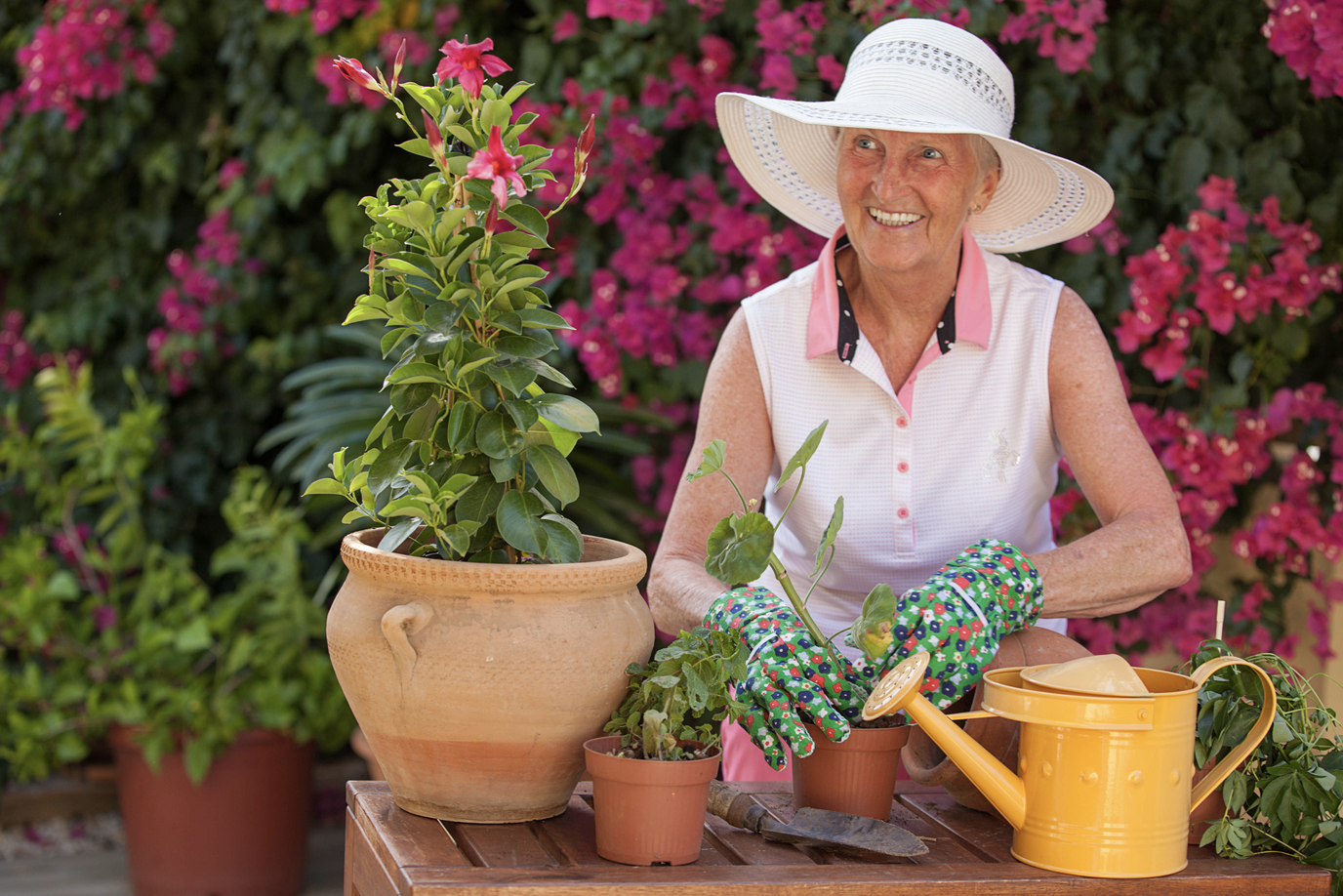
The bees are a buzzing and the flowers are blooming! It’s that time of year to take out your gloves and spades and get to gardening!
Gardening is a favorite pastime all over the world. People garden in different ways and for different reasons. Some garden to beautify their homes – creating curb appeal with beautiful flowers and shrubs. Others create hearty vegetable gardens providing fresh delicious veggies through the spring, summer, and fall. Whatever the reason, there’s no denying the world is in love with gardening.
Why not you too?
If you loved to garden in your youth, chances are you still love to garden now that you’re older. Well, while you are pulling weeds, or repotting a plant, you are also helping your body. That’s right, gardening can be beneficial for seniors because it keeps you active and helps improve motor skills. It may even help reduce Dementia as Five Star Senior Living states, “one study shows it may lower the risk of Dementia by as much as 36% percent.” So why not do something you love to do, that gets you outside and allows you to be creative while simultaneously improving your health. No reason at all; however, it’s important to first make sure you have the correct tools.
Gardening 411
So what if you love to garden but you can’t keep up with the bending or digging anymore? We asked Beverly, a garden hobbyist to tell us of her difficulties gardening throughout the years.
“I remember planting Phlox flowers on the side of my home and I had to create eight, 12-inch holes. Because I didn’t have the correct tool, I ended with carpal tunnel syndrome in my right hand. I should have had a post digger to create those holes. But I had used a spade to dig through clay/dirt and ended getting a steroid shot to resolve the carpal. That was the way I gardened when I was younger, but now I realize that having the proper supplies can make the job run smoother and keep me safe.”
What many don’t realize is that as you get older you may need to look into supplies that make your gardening experience more pleasant. The way you used to garden may not be how you will continue to garden in the future. You have to be realistic about what you can and can’t do.
Products to make gardening easier
It might be difficult for those who deal with bad knees or arthritis to go out and work in the garden as they had years before. Don’t fear, there are solutions to help make your gardening process easier. Here are some gardening tools recommended for seniors.
The Garden Kneeler has thick padding for you to place your knees on when you are in your garden bed. It has a steel frame on each side to support lowering yourself to the ground safely and stability for getting back to your feet. What’s perfect about this is that you can flip the frame so that it turns into a bench for those who are gardening with a raised bed garden.
Gardening Table Every senior needs a gardening table so that potting plants is a joy instead of a chore. No bending or stooping while working at a table and your tools, spade, snippers, whatever, are easily accessible. See the Campaign Roll Top Table from Garden Fountains.com. It’s just what you need to create beautiful potted plants.

You can use this table to help you fill in the dirt for you potted plants so you don’t have to bend over. It has open grooves so that the dirt can easily slide back to the ground. It has a pertain oil finish to resist moisture which is great for keeping it outside.
Loppers are a must have item when you want to relieve the stress on your back. Every gardener has a good pair of handheld snippers. However, these loppers help to get into those difficult places and can also help protect you from thorns while cutting rose bush stems. These are also perfect for pruning trees.

Safety is key
Using these tools can help you when gardening but Beverly tells us no matter what tools you have, don’t be afraid to ask for help. “Don’t do anything that could harm you!” Beverly relates to the time she stood on top of a plant stand trying to hang a plant over her patio doors. The stand wobbled and she fell breaking her foot. So the number one safety tip is if you can’t reach something – get help or get a ladder and be sure you have someone there to support the ladder while you are on it.
Lastly, you can have all the gardening tools in the world, but if you don’t know how to use them, they won’t do you any good. Seniors, be sure to educate yourself on how to properly use the products shown here and any others you may acquire.
Make it a family tradition
Gardening is a wonderful way to get all the family together. Start involving your little grandchildren in potting plants. Remember, to them, picking up dirt is fun. Help them plant some flowers or vegetables and when they grow, show them what they helped to create. Make them a part of the process by allowing them to water the plants whenever they come by to visit. Ask your son or daughter to help with clearing away weeds or dead leaves or perhaps they could try creating a small water feature in your garden using a pretty ceramic bowl with colorful rocks. Gardening can be a great bonding activity for the whole family. Best of all, everyone can take pride in the life they helped to create in your garden.
72-Year-Old Grandfather Teaches Himself How To Make Music
Rapper and youth advocate Andre “Add-2” Daniels was not expecting for his life to change with a single post to Instagram – but he was in for a surprise. Arthur Dubois, a 72-year-old grandfather, walked into Haven, a free music studio for the kids located on Chicago’s south side. He asked the owner Andre if he could play his music for him.
Daniels, surprised by the request, explained to Arthur that this was a studio for the youth, but Arthur responded by saying he was “young at heart”. Andre was hesitant, thinking maybe one of the kids from his studio was playing a joke on him but Dubois was so persistent he decided to give it a listen.
Why Andre pushed the record button
Andre couldn’t believe what he was hearing. Not only were Arthur’s beats good but they were also beats for trap music, a sound mostly loved by young adults.
“His beats sounded exactly like the beats I hear my 16, 17, 21-year-old mentees rapping to. I thought it was a fluke. I went to the next one and it was just as good, then the next and the next. Each time I was in pure disbelief.” Andre says in an interview with CBS News.
Why you’re never too old to learn something new
Arthur started teaching himself how to make beats 6 years ago by using a music program called Protools on his computer. Before then Arthur didn’t even know how to use a computer. He quickly realized learning the computer was essential to making beats.
“I got the book Computer for Dummies and went at it!”
We asked Arthur if any of his friends his age were also into computers. “Not many of my friends know about computers and my one friend always asked for someone else to do it for him”, Arthur states.
Arthur is now a social media success story
Andre published the video on social media and it immediately went viral. Since then Arthur and Andre have appeared on MTV and Windy City Live. They have also been the subject of various news articles. There might even be a movie in the future!

When asked how he feels about becoming an overnight success he says, “It’s overwhelming – but I wanted people to hear my music and now they are.”
Technology is not just a young man’s game. Arthur proves any age can adjust to a more technology-driven world. In his words, “you just got to do it and stick with it”.
It’s been said that seniors are sedentary and inflexible. However, couldn’t the same be said about millennials? If they had to revert to using a rotary phone would their fingers know how to dial? Who knows, perhaps our generational gap is closing in the name of technology.
Arthur offered his final advice to seniors about using computers, “Don’t ask for someone else to do it for you, do it yourself”.
Aging Design Expert Lisa Cini Shares 10 Safety Tips for Living Independently During National Senior Independence Month
 Nearly 90% of seniors 65+ prefer to live at home before considering a retirement or assisted living community for reasons including economics, the stress of moving, the fear of losing independence, emotional ties to the family home, and fear of the unknown.
Nearly 90% of seniors 65+ prefer to live at home before considering a retirement or assisted living community for reasons including economics, the stress of moving, the fear of losing independence, emotional ties to the family home, and fear of the unknown.
Expert on aging Lisa Cini provides tips to live not only independently, but energetically with increased safety, including aids to mobility, lighting effectiveness, cooking safety, bathroom safety and more.
“Thanks to medical advancements, exercise and healthy eating, seniors are far healthier and living longer and more independently,” says Cini. “Small, simple and cost-effective modifications can make a big difference in improved safety, hearing, mobility, sight and memory.”
Independent living updates include:
1. Adjust the heights of sinks, stoves, washers & dryers, showers, shelving, and cabinets.
2. Declutter and organize trailing electrical wires to avoid slips and trips.
3. Add banisters and check for looseness on stairs, railings and decks.
4. Light up dark hallways and closets with motion-sensor lights to prevent falls.
5. Install handrails/grab bars by the toilet and in the shower to stay steady.
6. Get tech: There’s a bevy of wearable technology for improved mobility, heart monitoring with the touch of a finger, memory assistance, companionship, fitness and mobility; and new, unobtrusive vision and hearing aids that can translate 27 languages, detect falls, connect to your phone, and can even be found by GPS tracking when you can’t remember where it is. Home security systems can protect against theft and property damage, provide motion sensing lights to detect intruders, and provide welcome hall way lighting. Tablets and portable screens allow you to send photos, videos and have live chats with family and friends.
7. Install an automatic stove shutoff device to provide peace of mind and protection when cooking is forgotten or left unattended. It’s an easy way to prevent a possible fire and save dinner, too.
8. Make flooring safe. Make sure there are rugs on polished floor surfaces. Invest in anti-slip tiles for bathrooms and kitchens to avoid sliding on water spills. Rugs should have anti-slip fixtures underneath to avoid slipping. Consider a contrasting color for steps and rails to make them easier to see. And, since your feet spend so much time on the floor, wear well-fitting shoes and slippers. Avoid flip-flops as they lead to trips.
9. Keep things within reach. Stretching and balancing on step ladders to get things on high shelves or in awkward places leads to falls. So, keep things you use frequently in an easy-to-reach place. Place a phone within easy reach for an emergency, and set up speed-dial for favorite contacts.
10. Make the garden safe. Clear moss and old leaves from the paths to minimize the risk of slipping. When it is icy, make sure you have some grit and someone to clear your paths. Avoid too many pots and ornaments, as they are easy to trip over. Install lighting so you can see your way along paths in the dark. Remember that you don’t have to do all the work in the garden or house; you can get help from others to do the heavier jobs, which lessens your risk of falling.
If a retirement or assisted living community is the best choice, new facilities are cropping up to provide independence for residents. For example, Mosaic Design Studio’s recently completed assisted living facility, YourLife of Palm Beach Gardens, Florida, was designed to provide many options for residents from décor and dining to activities, encouraging multi-generational interaction, integrating technologies that facilitate independence, and providing an atmosphere that feels like home – and maybe even better.
“The first step to making the right choices is knowing that for most of us there are choices,” says Cini. “Follow that with an honest assessment of your health, finances, life preferences, and the viable options, and the world of possibilities may open wide.”
Lisa Cini is an award-winning senior living architect, author, speaker, and President and CEO of Mosaic Design Studio, which applies the latest thinking and technology to the design of senior living communities, assisted living facilities, and memory care facilities throughout the country.
2019 Health Forecast for Women

As we head into 2019, Maria Sophocles, M.D., OB/GYN at Women’s Healthcare of Princeton, reminds us not to believe every trend a celebrity touts, and describes what’s new as well as tried and true solutions to recurring, embarrassing health issues and new technology to keep us safe and more comfortable as we age.
“Women’s health trends over the past year have kept us gynecologists very busy! We have seen the introduction of ‘vajacials,’ CBD vaginal suppositories, and even vulva highlighters to enhance the appearance of the vagina. All the while, education and real solutions related to maintaining optimal health have been pushed to the side,” says Sophocles. “It’s time to shift the conversation and set the record straight.”
Here’s what’s new:
- Finally, a real solution to urinary/fecal incontinence without surgery or pills or pads. Pending FDA approval, Attain by InControl Medical, the first over-the-counter, non-implantable muscle stimulator with biofeedback to treat stress, urge, mixed urinary and fecal incontinence in men and women.
- The Replens Brand now offers a complete family of products that work together to provide a comprehensive solution to both internal and external vaginal dryness for all ages due to menstruation, after childbirth, while nursing or as a symptom of menopause and beyond. Hormone-free Replens Moisturizer corrects the root cause of dryness by hydrating the vaginal tissues, replenishing moisture and rejuvenating dry vaginal cells for three days. Replens External Comfort Gel soothes the outside skin surrounding the vagina when it becomes irritated and painful during sex, walking, prolonged sitting, and exercising, and leaves behind a protective barrier to help prevent further irritation while penetrating and softening the skin. Silicone based, Replens Silky Smooth should be applied just before sex to ease penetration, reduce abrasion and enhance sexual activity.
- Good news for women suffering with hot flashes: Divigel, a topical gel that delivers estradiol, estrogen identical to that produced naturally by the body prior to menopause, will soon be available in 0.75 mg to help women experiencing hot flashes and night sweats.
- Less is more to maintain vaginal health. Scented products, cleansing wipes and detox masks usually do more harm than good. Remember that as long as you keep your vaginal pH in the normal range of 3.8-4.5 with RepHresh Gel, you most likely will not experience odor or other more serious issues.
- vitafusion is now the only vitamin brand with clinically proven equivalence to traditional vitamin tablets and caplets when it comes to absorption. In the first clinical studies of its kind, Vitamin C gummies and Vitamin D gummies from vitafusion were compared to their respective caplet and tablet counterparts for absorption, the key measure of effectiveness. The Vitamin C study concluded that the vitafusion gummy was just as effectively utilized by the body as the caplet form. The Vitamin D study showed the gummy to be, in fact, more effective than a tablet.
- Lisa M. Cini makes available the latest technology curated from around the world, specifically designed to help our family members age on their own terms with the freedom to safely maintain their independent lifestyle with items for the home, healthy living, memory assistance, companionship, fitness and mobility, and vision & hearing.
Tried and true Wellgate Wrist Supports help women ease painful symptoms of tendonitis, arthritis and sprains and provides rehab for painful symptoms of Carpal Tunnel and Thoracic Outlet Syndrome without surgery.
New Year Resolutions For Technology
Innovation and technology are sure to make their mark this year on the aging services industry and will be hot topics at HealthTAC East 2019. The immersion event for senior executives working in independent/assisted living, memory care, and/or skilled/short-term rehabilitation will be held at the Grand Hyatt Baha Mar in Nassau, Bahamas, April 7-9.

Senior Living News reached out to a few of the scheduled speakers to ask what was happening in their organizations that excited them the most.
Kristin Kutac Ward, president & CEO, Solutions Advisors Group:
As we start 2019 and embark on our 10th year as a now not-so-new company, I am most excited about finding innovative new ways to inspire our team members and our communities to realize their full potential. “Recruit right,” “retention rewards” and “recognize regularly” are buckets of programs and initiatives we are focused on for 2019—our “Year of Inspired Solutions!” We are all excited to see what this wonderful new year will bring and will be working regularly to inspire solutions driven by purpose, honesty and passion for team members and owners alike.

Doug Leidig, President and CEO, Asbury Communities, Inc.:
I continue to be excited about the potential that new technology has for transforming aging services. It brings tremendous opportunities to lengthen and strengthen the health gains that senior living communities provide and to enable us to carry our expertise far beyond our campuses.
At Asbury, we have 90-plus years of expertise in understanding what helps people age healthier and happier. Couple that with new technology applications, and we, like our colleagues, have a lot of innovative ideas to share.
For the past two years, we have been laying the groundwork for several pilots that include testing how robotics and voice technology can be utilized as engagement tools, and most recently a tech-enabled mobility enhancement program that we expect will have major health and operational benefits.
Now, we’re in the implementation stage with those, and in the very early stages of exploring how we might create a technology product to address Type-2 diabetes. And we’re beginning to see the results of a telemedicine partnership we entered in 2018. It’s an incredibly exciting time.

Larry Carlson, President and CEO, United Methodist Communities:
“As United Methodist Communities (UMC) heads into the New Year, I am excited about how UMC is embracing and capitalizing on technology. UMC credits its status as a long-standing leader and expert resource to both its responsiveness to the needs of older adults and to adapting technological innovation.
Among the beneficial outcomes, technology realizes increased proficiencies. Associates and physicians across the organization electronically document resident records in real time and can access information from any location. Homecare associates employ video conferencing to connect clients with family members. Admit+ seamlessly admits new residents and clients, creating greater time efficiencies for everyone.
Daylight IQ or COMS software helps manage comorbidities by creating proactive clinical assessments several times a day, which allow fact-based care decisions to occur before health conditions worsen. It promotes rehabilitation and functional gains.
UMC has partnered with a technology start-up company, TOGGS, to test their radar technology to track motion, sleep patterns and respiration. It is our hope that this technology can assist our associates be more timely and effective in their safety oversight and care provision.
Our latest game changing technology, VirtueSense, utilizes a 3-D camera to identify balance, gait and functional deficits. When compared to the norms, the baseline metrics inform care plans or corrective exercises, as well as measure progress. The long-term goal using this tool is to reduce falls.
These technologies demonstrate UMC’s commitment to value-based health care. They maximize individuals’ independence, safety, and quality of life, but most importantly, these vital tools support our mission: Compassionately serving in community so that all are free to choose abundant life.

Lisa Cini, President/CEO, Mosaic Design Studio
I’m looking forward to sharing all that I’ve learned in the past year. I was shocked by the results of my national survey—the largest regarding marijuana and cannabidiol (CBD) use by baby boomers and those older. And with 83% of the 11,000+ respondents using some form of cannabis, either for medical, recreational purposes or both, I believe the study will generate some much-needed dialogue—for those of us designing environments and recommending products for seniors, those living in intergenerational households, and senior living leaders grappling with marijuana use in their communities now or in the future.
I traveled to Cuba, India, China and Mexico on business, mission and research trips in 2018, and selected my top 2019 product picks that help the 50+ crowd live more rewarding, safe and independent lives—a robot mop, a hearing aid that also translates 27 languages and offers a host of safety features, a bidet toilet seat, to name a few. I purchased and am designing an age-friendly Airbnb where boomers can try out the latest tech to age in place during their stay.
I’m very excited about the new year and look forward to keynoting at HealthTAC East 2019!
 Cheryl Slavinsky
Cheryl Slavinsky
As editor of Senior Living News, Cheryl curates the news for the website and writes a weekly feature story. She also plans the education portion of the HealthTAC events produced by Senior Living News twice a year and moderates the executive panel discussions. Cheryl has consulted with senior living clients for more than 20 years and served as senior public relations strategist for Varsity, a marketing and sales consulting agency focused on occupancy for retirement, assisted living and continuing care retirement communities (CCRCs)/Life Plan communities, and more. She previously managed national media relations as Rite Aid's director of public relations.
To see more from Senior Living News, click here.
The Growth of Multigenerational Homes
A few years back, Amy Goyer, family and caregiving expert with the AARP, was living with her father, one of her sisters and her two nephews under one roof. Her father suffered from Alzheimer's disease, and Goyer said that having him live with her helped alleviate some of her worry about how he was doing. "It was much less stressful because I was on top of and coordinated his care," she said.
Goyer is far from alone when it comes to multigenerational living. Whether it's to help an aging parent or for some other reason, multigenerational homes are growing in popularity. According to the Pew Research Center, a record 64 million people—about 20% of the U.S. population—lived with multiple generations under one roof in 2016. If the convention has been to grow up, move out of your parents' home and create your own life, why are so many families doing just the opposite these days?
Multigenerational homes: A timeline
Having multigenerational families living together may seem like a new trend, but the living arrangement has a long history in America. According to Pew data, the multigenerational-living model first took a nosedive after World War II. The number of people living in this type of situation dropped to 21% in 1950 from 25% a decade earlier. This trend continued until 1980, when the share of the population living in multigenerational homes bottomed out at 12%. A number of factors likely led to this shift, including a decline in immigration (more on why that matters later) and a rise in both health and wealth for people who were 65 and older.
Since the lowest dip in 1980, though, multigenerational living has been slowly on the rise, and the Great Recession from 2007 to 2009 helped. By 2009, 51.5 million (or 17%) of Americans lived in multigenerational households again, and the number has continued to go up since.
Why multigenerational living is making a comeback
It's no surprise that the U.S. saw an uptick in multigenerational living as a result of the Great Recession, when living with multiple people under one roof provided certain economic advantages, but there are other trends that have caused this increase. Immigration is one. Two groups who comprise more than 50% of immigrants living in the United States today, Hispanics and Asians, are more likely to live in multigenerational homes than white families, at a rate of 22% and 25%, respectively, compared to 13% for whites. "Especially among Hispanic families, it's much more common for it to be a given that households will live multigenerationally," said Goyer. "We also have the issue of the 'boomerang' kid and the idea that kids are emerging into adulthood at a much older age. They're turning 30 before they're fully independent."
Goyer also points out that the cost of care for both children and the elderly continue to increase, making moving in together a money-saving decision. "There's an increase in caregiving for older parents," she added. "As baby boomers are aging, that's going to continue to grow an older population that needs help, and moving in together can help provide that care."
On the opposite end of the spectrum, the rising cost of child care likely has something to do with this shift as well. "It's not just single adults choosing to live with the parents longer—it's more common now to be married with kids and living with your parents, so there are three generations in the same household," said Patrick Doherty, certified financial planner with Reby Advisors. "It cuts costs and adds support. When grandparents can watch the kids—especially in a household with two working parents—sometimes they can cut out the cost of child care or make it more manageable. This also enables the parents to focus on their careers, if needed, because they have additional support."
The pros and cons of multigenerational homes
For Lisa M. Cini, president and founder of Mosaic Design Studio and author of "Hive: The Simple Guide to Multigenerational Living," it was the lack of privacy that she found hardest to handle as a multigenerational family. "I think one of the most difficult things for me is that I am an introvert, and when I got home, my mom, being an extrovert, would want to chat and ask me all kinds of questions," said Cini. "To me, it felt like I was 15 again and I was under an FBI investigation."
The lack of privacy got so bad that at one point, Cini said she started sneaking into her own house to get to her bedroom before her mom would know she was home. "I needed time to rejuvenate from having to talk to people all day and be on," she said. "I finally had to tell her that I needed an hour or so to get my mojo back before we chatted." Although the conversation was difficult, Cini's mom ultimately understood, and Cini no longer felt the need to sneak into her own house. Instead, Saturday mornings became their "catch-up" time, where they had coffee and chatted together on the front porch swing. "We created some wonderful memories this way and grew closer."
As a family and caregiving expert, Goyer said the kitchen is where she often hears about the most conflicts in multigenerational homes. In fact, "having other people use my kitchen has been one of the hardest things," she admitted. One woman confided to Goyer that she would get frustrated because her mother had recently moved in and could not stop telling her how to make her sandwiches for her children as she packed their lunches in the morning. "It drove her insane," said Goyer.
But personal space complaints and long waits for the bathroom are balanced out by the perks of having so many members of the family living under one roof. "Having been raised with my grandparents in the house, I can say from firsthand experience that the benefits are many," said Domingo Perez Jr., a licensed real estate salesman at Warburg Realty. For example, Perez Jr. pointed to the fact that his parents never had to worry about getting a baby sitter, and he got the opportunity to bond with his grandparents. "You'll always have a full table at dinner, you'll never worry about your parents traveling to get to your place, and everyone goes their own way at the end of the night, but never too far away," he said.
Deborah Heiser, 50, agrees that having a grandparent around is a major perk. She and her husband and two sons live with her 92-year-old mother-in-law in a home in Great Neck, New York. "The bond [my sons and mother-in-law] share wasn't as strong before she moved in with us," said Heiser. "I also love that my boys are able to see that at 92, their grandmother travels, is extremely social every day, and she always has a treat or snack handy for them. They don't see older adults as a burden or as invalids. They have an expectation that life can be exciting and fun at any age."
Science backs up the idea that close bonds with a grandparent benefit everyone involved. According to one study, kids who grew up close to their grandparents were less likely to be depressed as adults, while on the flip side, another study found that grandparents who baby-sit tend to live longer than those who do not care for other people.
For college grads moving back home, social psychologist Susan Newman, Ph.D., sees another advantage. The most significant positive in that type of situation "is getting to know each other as adults, as people, rather than as mommy-daddy/child," she said. "All parties bond in new ways, some surprising, such as discovering a mutual interest in a sport or adventure or music or art, that they can explore together."
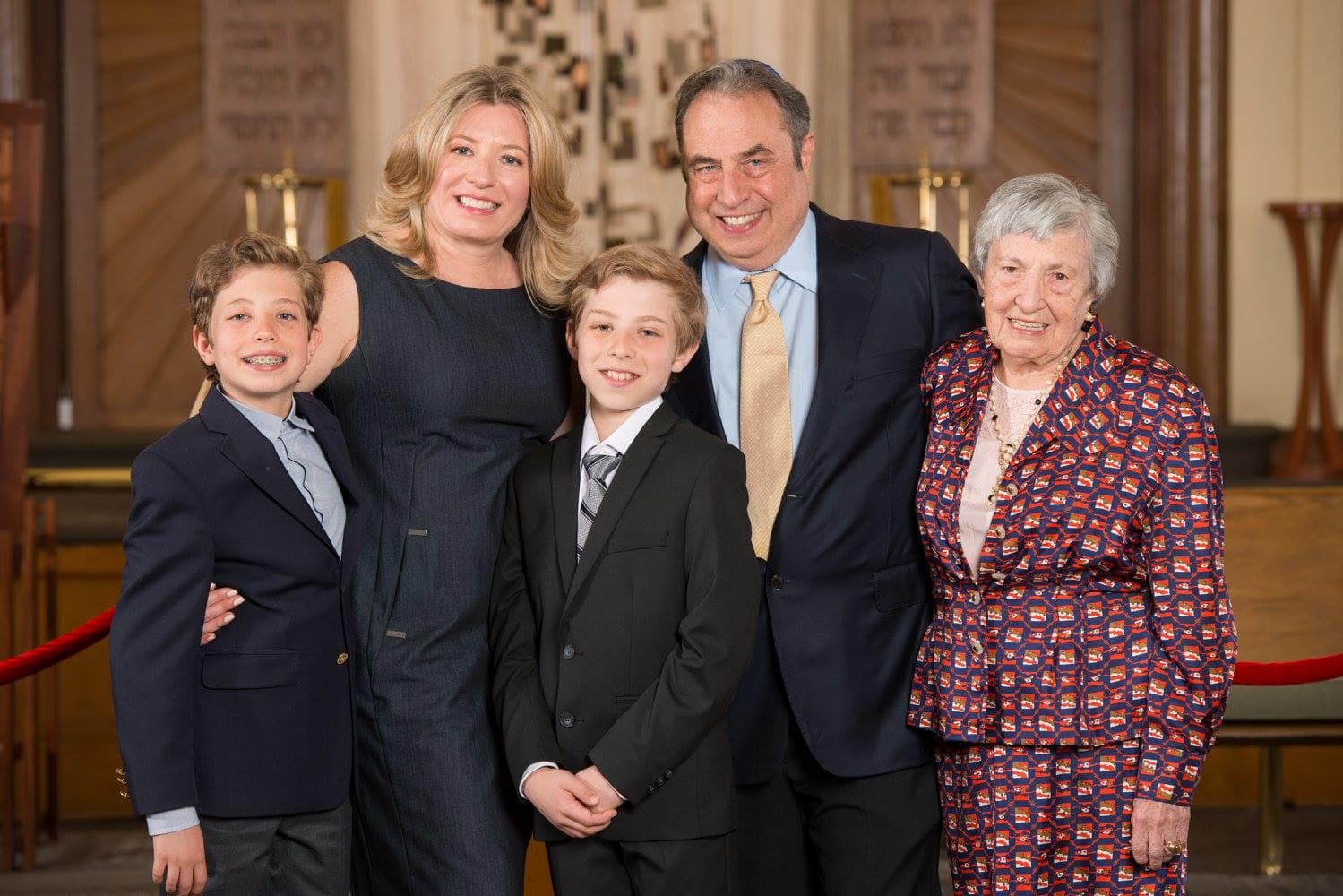
Tips for living together under one roof
Whatever the reason for moving multiple generations together in the same household, there are some fairly important things to consider in order to make the situation run smoothly. Goyer recommends first considering your house. "Ask yourself, 'Do we need to modify or make it safer for older adults, children, people with disabilities?'" she said. "Consider how you can use the space so that people have space of their own. That's important, especially if you're moving in together and have lived separately, since all parties have been used to having control over their space."
Goyer also recommends making it a priority to take time away for yourself, while also maximizing the opportunity for intergenerational exchange. "You can facilitate that connection between generations and make sure it happens by having family meetings and family game time, and checking in with people to ask how it's going."
Along these same lines, if your main purpose for setting up a multigenerational family under one roof is for caregiving purposes, keep in mind the entire household is affected by the family member who needs extra attention. "When my nephews were here, it was hard for them living with my dad with Alzheimer's, and I had to be aware of that," Goyer said. "It was important for them to get out of the house and have other things going on, so we made time to go out to the movies and do the things they enjoyed, not to have our whole lives rotate around caregiving."
Concerning finances, John S. Longstaff, CFP and senior planner, suggests securing a financial commitment from each member of the household who is able to do so. For example, "financially, a portion of Social Security or pension goes a long way to make it seem [older parents] are participating in their expenses," he said. And even those household members who can't help with money should find other ways to contribute. "They can help with things around the house, like cooking, grocery shopping, cleaning and laundry," Longstaff said.
No matter how much prep families put into multigenerational living, things can always go awry. For example, there is always the possibility that one or more members of the multigenerational family can get too dependent or accustomed to this particular way of living, which may cause problems for other members of the house. "Young adults get dependent and accustomed to the low cost of living in their parents' house, so sometimes they don't have the motivation to move out," said Doherty. "Or grandparents who live with their adult children and their grandchildren sometimes feel obligated to help raise the grandkids. Oftentimes they feel trapped. Their adult kids use them for day care, sitters and transportation. They end up feeling like they can't go on their own vacations or enjoy free time because their kids need their help and maybe can't afford child care because they haven't budgeted for it."
Why multigenerational families need to talk things out
Making sure that all family members understand and weigh both the positives and negatives before moving in can help prevent huge fights. It's also important to establish roles and boundaries for each household member, including clear-cut expectations of who is paying for what. For an adult child moving back home, Newman also suggests creating an exit plan if the situation is meant to be temporary. "You can always revisit it in six months and revise or extend the time as needed," she said.
Cini stresses those who live in multigenerational homes should also have ground rules in place for handling common disruptions to the routine, such as inviting over guests. Within her own multigenerational family, she said they discussed when they could have family or friends over, and when approval would be needed. "Luckily, no one ever had people over that the other didn't like, but imagine if your mother lives with you and your mother-in-law comes over and they hate each other," she said. "This could create a lot of stress. Think of it like a wedding reception and who needs to sit next to whom, and who is off the guest list altogether."
Multigenerational homes aren't for everyone, but the proof that it can provide long and lasting benefits is fairly solid. Of course, if a longer life, closer family ties and financial help aren't enough of an incentive, Cini said her parents also enjoyed IT support service 24/7 by living with her and her daughter.
Lisa Cini’s 2018 Best Living Tech Holiday Gifts Curated from Around the World for Parents and Grandparents
Best Living Tech announces this season’s holiday gifts that are specifically designed to help Mom, Dad, Grandma and Grandpa age on their own terms with the freedom to safely maintain their independent lifestyle. Both high-and low-tech gifts include items for the home, healthy living, memory assistance, zero-maintenance companionship, fitness, mobility, vision & hearing.
“Who are the truly challenging folks on your holiday gift list?” Cini asks. “For many, it’s our parents and grandparents who may seem to already have everything they need. But do they really? I have searched the globe to make the latest technology available for personal gifts that are helpful, lifesaving and functional.”
Here are just a few ideas:
- • The Human Charger – Valkee Light Therapy Device is a revolutionary bright light therapy device that will increase energy levels, improve mood, reduce the effects of jet lag, increase mental alertness and fix the winter blues.
- • The Piper Smart Home Security System with Night Vision and the Ring Video Doorbell 2 -Home Security System are both easy to install and make everyone feel confident and secure.
- • Whether alone, visiting with friends, or playing with the grandkids, the Hasbro Joy for All companion pets (cat or dog) will bring both a smile to old and young alike. They’re soft, cuddly, and best of all they respond to petting, hugging and motion just like the real thing we all know and love.
- • No one should ever feel alone, isolated, or out of touch. The Loop, lets family and friends video-chat with ease. Its voice operated, works as a Bluetooth speaker, and was described by Time Magazine as one of “the 9 coolest gadgets from this year’s Consumer Electronics Show.”
“From fitness and mobility aids to things like stove safety alerts, consider holiday gifts that will not only make lives easier, they’ll give you piece of mind as they are used and appreciated for years to come,” adds Cini.
To view all the gifts to consider this year, please visit: bestlivingtech.com.
Lisa Cini
Lisa Cini Talks Tech At NBC
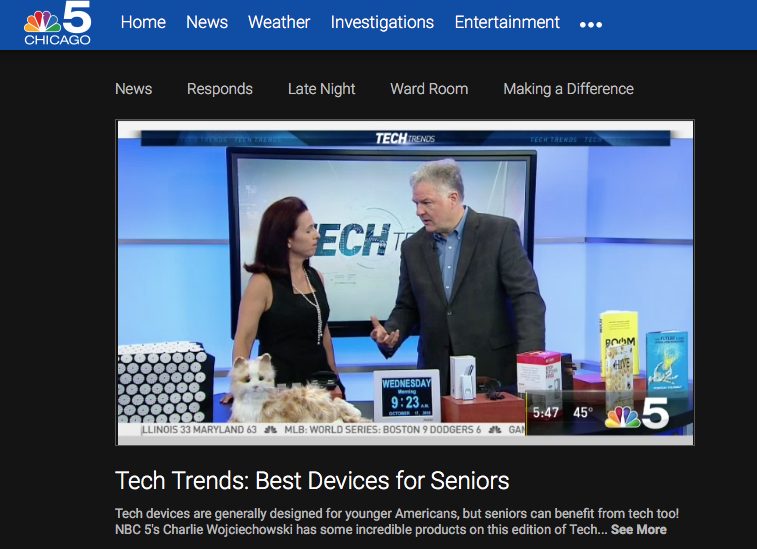
Check out the video here.
Multi-gen Living Takes the Spotlight at the Washington Post

Best Living Tech Founder and CEO Lisa M. Cini was featured in an article in the Washington Post last month with financial columnist Michelle Singletary on the benefits of multi-generational living. In the full article HERE you’ll see that they talk about more than the financial benefits – there are plenty of intangible emotional positives that come with a shared multi-gen living structure.
In addition to the column, Lisa appeared along with Michelle on her regular weekly Live Chat forum, ‘The Color of Money Live” where you can see from the transcript here that Lisa gave some great one-on-one advise about a variety of family issues.
Elders love social connectivity
How social media impacts and changes the lives of aging communities
What does being 92 years old, Facebook, and assisted living have in common?
If you have met my great Aunt Helen, you would know. She lives in an assisted living facility in Canton, Ohio, is 92 years old (so she says, but the women in our family have a tendency to lie about things like this), and uses Facebook to stay in touch with her family and loved ones. It took her two weeks to accept me as a friend! At that time she had over 200 friends but since then has “cleaned” her Facebook and recommend others to follow.
You may be thinking, Oh, she’s a little old Italian lady that probably reads what is said but does not actually converse back and forth. Wrong! She prays for us, wishes us happy birthday, and when I posted that I took a shot at making my grandmother’s recipe for Pina—an Italian Easter bread—she asked how it turned out and said that she made it as well.
So why am I blabbering on about my aunt, Facebook, and assisted living? It’s simple: Design Professionals and the LTC field need to wake up! We need to be designing for our loved ones to stay connected and Facebook and the Internet are two of the greatest tools. Everyone can communicate at any time, versus having to wait for a visit or phone call. I consistently hear operators and staff insist that their residents would not use the Internet or Facebook. I’m not sure if they realize how belittling they are being and that they are taking away another connection to their families and loved ones. Wouldn’t it be something if using the Internet became an activity for the residents? We could design great space for seniors to get online, have headsets for ease in listening, use larger fonts and screens, and make Internet usage a daily or weekly activity at the least.
So the next time you think your residents are too old to use Facebook, remember Aunt Helen. I vote to Helen-ize all assisted living.
U.S. housing costs spurring multigenerational households
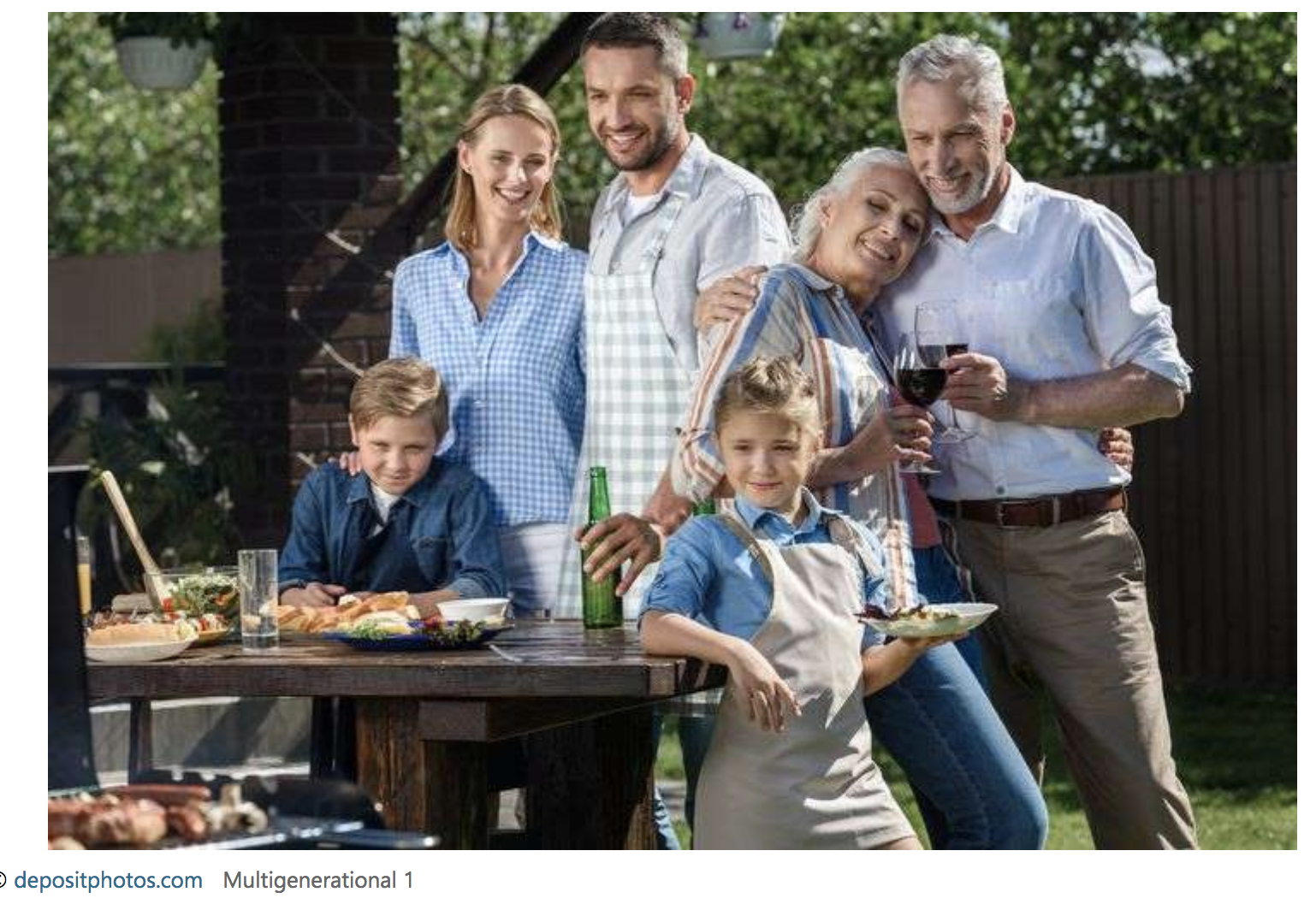
Multigenerational living, defined as a household that includes two or more adult generations, has become more common in recent years. According to the most recent Pew Research Center analysis of census data, a record 64 million people (20 percent of the U.S. population) lived in multigenerational homes in 2016—up from 60.6 million Americans (19 percent of the U.S. population) in 2014 and 51.5 million Americans (17 percent of the U.S. population) in 2009.
Why multigenerational living is on the rise
Shifting economic circumstances, an increase in cultural diversity, and evolving lifestyles of older Americans are just a few reasons why families are embracing this type of living arrangement, but perhaps the biggest reason that’s causing this shift is the lack of affordable housing and housing availability in this country.
The housing market
As we all know, the housing market is a giant migraine right now. In March, home prices rose 8.9 percent over the same time a year ago while housing inventory dropped 13.6 percent over the past year. Throw in the lack of new-construction homes and you have a buyer-crowded market where supply just isn’t meeting demand. Multigenerational living is a solution to this problem, providing a more affordable option for those who can’t buy a home in this current real estate climate.
Kevin Mejia has lived in a multigenerational home his entire life. “My mom is a single mom and living with extended kin was the best from a financial perspective,” says Mejia. Though Mejia doesn’t get much privacy, a common drawback of multigenerational homes, he avoids paying exorbitant rental costs. In New York City, where Mejia lives, and other places around the country, rent prices continue to rise faster than wages, making it extremely difficult to live comfortably on your own. In fact, Mejia says that many of his friends still live with parents and grandparents for this very reason.
Cultural trends
Growing racial and ethnic diversity among the US population also helps explain why multigenerational living is on the rise, according to the Pew Research Center. Though multigenerational living is growing among nearly all US racial groups, Asian and Hispanic populations are growing more rapidly than the white population, and those groups are more likely than whites to live in multigenerational family households. From 2009–2016, 26 percent–29 percent of Asian populations and 23 percent–27 percent of Hispanic populations in the States lived in multigenerational households. Only 13–16% of whites lived in a multigenerational home from 2009–2016.
Social implications of multigenerational housing
Previously, the primary demographic living in multigenerational households were adults aged 85 and older, but in recent years, young adults have more and more opted for this living arrangement: As of 2016, 15 percent of 25- to 35-year-old Millennials were living in their parents’ home. This figure is five percentage points higher than the share of Generation Xers who lived in their parents’ home in 2000 when they were the same age (10 percent).
This shift could be caused by the dramatic drop in young Americans who are choosing to settle down romantically before the age of 35. Or we can factor in the Great Recession that led to weak employment opportunities, high unemployment rates, and college enrollment expansion (that led to massive student loan debt) that pushed young adults to live with their parents during this period. The numbers show that even if Millennials are able to get out of their parents’ homes, student loan debt, low housing inventory, and housing costs that continue to double year over year are a barrier to homeownership.
Elderly assistance
Another reason why some families opt for multigenerational living is because aging family members require more care, and nursing homes are becoming more difficult to afford. In 2017, the median cost of a private nursing home room in the United States was $97,455 a year, up 5.5 percent from 2016, according to Genworth’s 2017 Cost of Care survey. Considering the medians savings account balance of Americans over 65 is just $10,000, it’s not surprising that families step in to help. To counteract these costs, families are buying homes with multiple living areas or remodeling their current homes to make space for their parents.
“I think as home prices continue to skyrocket alongside healthcare costs, we will see more pre-planning along these lines as middle-aged people think about their next housing move,” says Misty Weaver, realtor at the Dream Weaver Team. “Even my clients that initially want to downsize end up in a home that can somehow accommodate older family members.”
There’s also the issue of single parents working or dual parents working, which can be problematic when caring for kids and getting them to and from different activities. “With a multigenerational household, this stress is relieved and everyone can thrive,” says Lisa Cini, ASID, IIDA, who has more than 25 years of experience developing interiors that improve the quality of life for seniors, and who lives in a multigenerational home herself.
Companionship and family bonding
Another reason some families choose to live intergenerationally is for the companionship. Cini reflects on how her multigenerational home fosters companionship between her parents and children. “My parents say they love it because the kids have so much energy and are so fun, that they actually have more energy being around them!” says Cini. She recalls how her own children love the wisdom imparted from their grandparents and great-grandmother and love hearing them tell stories about when they grew up.
“The kids also love being able to be the ‘tech experts,’ teaching [my parents] all about their smart phones, Facebook, Instagram and Snapchat,” says Cini. And the learning goes both ways. “There’s something special about having your grandmother teach you her recipes or take care of you when you are ill.”
Restrictions on multigenerational housing
Some cities have introduced permits and zoning laws that make it harder for families to live in a multigenerational home. For example, some municipalities, like Raleigh, North Carolina, and Cherry Hill, New Jersey, have banned accessory dwelling units (ADUs), also known as granny flats, mother-in-law suites, and garage apartments, on properties. ADUs are small, self-contained residential structures that share a lot with an existing house and are often used as rental properties or private living spaces for family members.
But in Los Angeles, California, and Austin, Texas, ADUs have proven to be a popular means of expanding housing options, providing independent living quarters for aging family members, and granting property owners an additional source of income.
California, home to some of the country’s most in-demand and expensive real estate markets, recently passed laws that would ease restrictions on building a second unit on a piece of land. According to the LA Times, “In Oakland, the planning department approved 266 so-called accessory dwelling units (ADUs) in 2017, up from 126 a year earlier. In Long Beach, 96 applications are pending and the city has approved 15 this year, compared with 21 approved in all of 2017 and none a year earlier. The largest growth is in Los Angeles, where 2,342 secondary units were permitted in 2017, up from 120 in 2016.”
In Austin, Texas, the Alley Flat Initiative aims to increase the city’s affordable housing stock and make it easier for families to add new units to their property. The Initiative helps families plan, design, and build an additional flat on their properties to accommodate extended family members. Through this process, an adaptive and self-perpetuating delivery system is created that promotes efficient housing designs and innovative methods of financing and homeownership that benefit all neighborhoods in Austin.
How real estate is responding to multigenerational living
According to Jason Biddle, a Certified Aging in Place Specialist (CAPS), the growing trend of multigenerational living has changed the types of homes that single-family volume builders are developing. Not only are builders constructing homes with more square footage, they’re including a separate wing for extended family members. “Many national home builders have introduced new products marketed to multigenerational homebuyers with features like a first-floor master, larger square footage, and even a separate-but-connected apartment suite to help maintain privacy,” says Biddle.
According to Weaver, most homes in Virginia are built with a basement and bath roughed in. “Builders understand that families are increasingly taking in older family members or expanding living space for themselves as they age and families grow. It’s almost unheard of in new developments to not have these features in the designs,” says Weaver.
In an interview with the Wharton School at the University of Pennsylvania, James Timberlake, partner at award-winning architecture firm KieranTimberlake, says, “In urban situations, where space is more precious, decisions have to be made about the value of the lot, and what you can build, and how many units you can build in that particular area, and whether or not there’s a market for that kind of multigenerational experience. I think what you’re seeing is that developers see this niche, and it’s a niche that more and more people desire.”
This article originally appeared on HouseMethod.com and was syndicated by MediaFeed.org.
Living Better 50 – Tech Items Every Savvy Baby Boomers Needs
By Lisa M Cini—
As you get older, daily tasks can become increasingly difficult. There are many gadgets on the market that can make life easier for baby boomers. The following are a few interesting gadgets you may want to have to make your daily life a bit easier.
Have a Security System Installed
Being home alone can be scary for many older people. Even if their spouse lives with them, there will be times when they will be at their house completely alone. Having a security system installed can help give you peace of mind that you are as safe as you can be at all times. The system will ensure that no one gets into your house when you are away from home and provides you with an easy way to get emergency assistance if you need it, without even having to dial a phone.
Have a Wi-Fi Smart Thermostat Installed
There are many older individuals who are living on a fixed income. They need to save money wherever they can and reducing electricity costs can be a great way to save. A Wi-Fi smart thermostat may be the best way for you to easily decrease your heating and cooling costs right away. Once the thermostat is installed, you can lower or raise the temperature on the thermostat to a cost-effective degree. Twenty to 30 minutes before you come home, you can go to an app on your phone to set the thermostat to a temperature that you feel is more comfortable. This means that the house will be at a comfortable temperature by the time you arrive, but you will not have to pay to maintain that temperature at all times.
Wear a Smart Wearable Device
A smart wearable device allows you to track your sleep cycles, heart rate, and the steps you take each day. It can also help you to know how many calories you are burning throughout the day. Smart wearable devices connect wirelessly to your cell phone so that you can look at the results on a larger screen and track the data for an extended period of time. This can be great information to have when you go to see your doctors because you will have tracked data you can show them.
Add Voice-Controlled Devices to Your Home
There are many times when it can be difficult to do things in your home simply because they require you to read very small print. Instead, you can have voice-controlled devices in place that will make it easier for you to do the things you want to do. There are now televisions that can be voice controlled, so you can find any programming you want to watch and even change the volume with your voice alone. There are also devices that you can use to research a topic that interests you, listen to your favorite music, or even have a recipe read to you.
Trying new gadgets can seem overwhelming or scary to many older people. It is important to realize that most devices that are on the market are designed to be easy to use and do not take long to master. This is because the manufacturers know that anything too complicated will not be popular with elderly individuals. These gadgets can help you live a more fulfilling, comfortable life for as long as possible.
BlogLovin – Tech Items Every Savvy Baby Boomers Needs
Tech Items Every Savvy Baby Boomer Needs
By Lisa M Cini
As you get older, daily tasks can become increasingly difficult. There are many gadgets on the market that can make life easier for baby boomers. The following are a few interesting gadgets you may want to have to make your daily life a bit easier.
Have a Security System Installed
Being home alone can be scary for many older people. Even if their spouse lives with them, there will be times when they will be at their house completely alone. Having a security system installed can help give you peace of mind that you are as safe as you can be at all times. The system will ensure that no one gets into your house when you are away from home and provides you with an easy way to get emergency assistance if you need it, without even having to dial a phone.
Have a Wi-Fi Smart Thermostat Installed
There are many older individuals who are living on a fixed income. They need to save money wherever they can and reducing electricity costs can be a great way to save. A Wi-Fi smart thermostat may be the best way for you to easily decrease your heating and cooling costs right away. Once the thermostat is installed, you can lower or raise the temperature on the thermostat to a cost-effective degree. Twenty to 30 minutes before you come home, you can go to an app on your phone to set the thermostat to a temperature that you feel is more comfortable. This means that the house will be at a comfortable temperature by the time you arrive, but you will not have to pay to maintain that temperature at all times.
Wear a Smart Wearable Device
A smart wearable device allows you to track your sleep cycles, heart rate, and the steps you take each day. It can also help you to know how many calories you are burning throughout the day. Smart wearable devices connect wirelessly to your cell phone so that you can look at the results on a larger screen and track the data for an extended period of time. This can be great information to have when you go to see your doctors because you will have tracked data you can show them.
Add Voice-Controlled Devices to Your Home
There are many times when it can be difficult to do things in your home simply because they require you to read very small print. Instead, you can have voice-controlled devices in place that will make it easier for you to do the things you want to do. There are now televisions that can be voice controlled, so you can find any programming you want to watch and even change the volume with your voice alone. There are also devices that you can use to research a topic that interests you, listen to your favorite music, or even have a recipe read to you.
Trying new gadgets can seem overwhelming or scary to many older people. It is important to realize that most devices that are on the market are designed to be easy to use and do not take long to master. This is because the manufacturers know that anything too complicated will not be popular with elderly individuals. These gadgets can help you live a more fulfilling, comfortable life for as long as possible.
Lisa Cini ASID, IIDA, is an award-winning, internationally-recognized designer with more than 25 years’ experience developing interiors that improve quality of life for seniors. She has advice for both designers and for those seniors seeking the right kind of independent living facilities for them.
Lisa is the author of The Future is Here: Senior Living Reimagined, Hive: The Simple Guide to Multigenerational Living, and BOOM: The Baby Boomers Guide to Leveraging Technology, so that you can Preserve Your Independent Lifestyle & Thrive.
Unique Housing Options for Boomers
Tech Items Every Savvy Baby Boomer Needs
By Lisa M Cini
As you get older, daily tasks can become increasingly difficult. There are many gadgets on the market that can make life easier for baby boomers. The following are a few interesting gadgets you may want to have to make your daily life a bit easier.
Have a Security System Installed
Being home alone can be scary for many older people. Even if their spouse lives with them, there will be times when they will be at their house completely alone. Having a security system installed can help give you peace of mind that you are as safe as you can be at all times. The system will ensure that no one gets into your house when you are away from home and provides you with an easy way to get emergency assistance if you need it, without even having to dial a phone.
Have a Wi-Fi Smart Thermostat Installed
There are many older individuals who are living on a fixed income. They need to save money wherever they can and reducing electricity costs can be a great way to save. A Wi-Fi smart thermostat may be the best way for you to easily decrease your heating and cooling costs right away. Once the thermostat is installed, you can lower or raise the temperature on the thermostat to a cost-effective degree. Twenty to 30 minutes before you come home, you can go to an app on your phone to set the thermostat to a temperature that you feel is more comfortable. This means that the house will be at a comfortable temperature by the time you arrive, but you will not have to pay to maintain that temperature at all times.
Wear a Smart Wearable Device
A smart wearable device allows you to track your sleep cycles, heart rate, and the steps you take each day. It can also help you to know how many calories you are burning throughout the day. Smart wearable devices connect wirelessly to your cell phone so that you can look at the results on a larger screen and track the data for an extended period of time. This can be great information to have when you go to see your doctors because you will have tracked data you can show them.
Add Voice-Controlled Devices to Your Home
There are many times when it can be difficult to do things in your home simply because they require you to read very small print. Instead, you can have voice-controlled devices in place that will make it easier for you to do the things you want to do. There are now televisions that can be voice controlled, so you can find any programming you want to watch and even change the volume with your voice alone. There are also devices that you can use to research a topic that interests you, listen to your favorite music, or even have a recipe read to you.
Trying new gadgets can seem overwhelming or scary to many older people. It is important to realize that most devices that are on the market are designed to be easy to use and do not take long to master. This is because the manufacturers know that anything too complicated will not be popular with elderly individuals. These gadgets can help you live a more fulfilling, comfortable life for as long as possible.
Lisa Cini ASID, IIDA, is an award-winning, internationally-recognized designer with more than 25 years’ experience developing interiors that improve quality of life for seniors. She has advice for both designers and for those seniors seeking the right kind of independent living facilities for them.
Lisa is the author of The Future is Here: Senior Living Reimagined, Hive: The Simple Guide to Multigenerational Living, and BOOM: The Baby Boomers Guide to Leveraging Technology, so that you can Preserve Your Independent Lifestyle & Thrive.
Baby Boomers Laugh and Learn – Tech Items Every Savvy Baby Boomers Needs
If you’re aging single, or your kids are grown and you’re tired of tending to the yard and doing constant home upkeep, why not look at some interesting alternative ways to live?
For instance, did you know that you can actually live aboard a cruise ship and that the cost is comparable to an assisted living facility?
How about getting a place together with several of your friends and having a girls’ night, every night? Have you considered life as an expatriate in a tropical paradise? You will be surprised to find out how affordable and stress-free that type of life can be!
Do your homework, and keep your mind open to possibilities that you’ve never considered before. As the young folks say, you only live once!
Cruising Through Life
Amazingly, life on a cruise ship is a great way to travel while taking advantage of amenities quite similar to those of an assisted living facility. Nearly all cruise ships offer all-inclusive plans that include meals, and there any many entertainment and exercise opportunities. Swimming pools and well-equipped fitness rooms are a fixture of most cruises, as are live music, shows and games. Plus, ships have onboard doctors.
Cruising costs are typically lower than what you’d pay in an assisted living facility. Consider that the average cost of assisted living is about $3,750 per month, though the costs vary widely by state. Cruises average less than $100 per night. Longer cruises offer even larger discounts, and often a couple’s discount for two people traveling together. There are also senior discounts, discounts for frequent cruisers, and points that you can stack up on a credit card. Be sure to check with the cruise line to see if they allow long-term passengers or sign up for an around the world voyage that lasts several months. For even more travel variety, you can try different cruises from the same departure point that travel to varied ports of call.
Endless Girls’ (or Boys’) Nights
Another alternative that people don’t often think of is sharing a home with some friends, Golden Girls style. A recent UCLA study points out that one in three baby boomers is unmarried, making this a growing trend. If you are divorced or widowed with several friends in the same situation – why not move in together? It will afford you companionship, fun, and assistance when needed. If one of you has a home that is conducive to home sharing, the others can simply pay rent. Or, you can each sell your homes and possessions and find something that suits all of your lives perfectly.
A large condo near the beach, perhaps? Let someone else do all the yard work and keep the pool sparkling. Your only job will be deciding what’s for breakfast and how long to stay in the sun.
Don’t have any suitable housemates? Check into senior home share programs to find some. The obvious benefit of this type of arrangement is the lowered cost for each participant.
Road Tripping
Love to get in the car and just drive? Did you ever consider making that your new retirement lifestyle? If nothing is holding you in the town where you live, why not get out the maps and plot your journeys?
The great thing about road trips is that they can be different things to different people. If you love camping, buying an RV and making friends in campgrounds around the country might be to your liking.
Alternatively, if you enjoy creature comforts and hate bugs, driving your luxury SUV to well-appointed hotels around the country might work best. Either way, you can stop to see the sights on your journey that you’ve always wanted to visit. Better yet, the costs will most likely be less than living in a traditional assisted living facility.
House Swapping
Have you always wondered what it would be like to live in a certain state or a particular town, or even overseas? House swapping for baby boomers gives you lots of options. After all, there is likely someone out there interested in finding out what living in your area is like, but not as a tourist.
Swapping homes gives you the opportunity to stay where you want with limited or no added costs. Of course, most baby boomers are empty nesters with lots of flexibility, making it easier to work out exchanges.
Moving to Paradise
Aside from just visiting somewhere tropical or amazingly historical, you might decide you’d love to live there. Growing numbers of American seniors are now opting to relocate outside of the United States, to great tropical areas like the Bahamas, coastal Mexico, Belize, and Costa Rica.
There are also large numbers of expatriates in countries like Germany, Japan, and the United Kingdom. Most seniors cite the cost of living in these countries as one of their biggest considerations before making a move, with rent and utilities averaging less. Additionally, many boomers find that hiring help in some areas is quite affordable, allowing them to relax and let someone else do the cooking, cleaning, and laundry. Of course, you can’t overlook the amazing scenery and culture in many of the places that are burgeoning with expats, as well as the wealth of activities available.
Look at all of your options before deciding on moving to an assisted living facility. You just might find that you’d prefer lying on a beach under swaying palms!
HEALTHTAC To Host Industry Leaders
A diverse group of speakers and attendees representing the senior/assisted living, memory care and skilled nursing/rehabilitation industry across the country and beyond will meet at the upcoming HEALTHTAC. Produced by Senior Living News, HEALTHTAC West 2018 will take place August 19-21 at Monarch Beach Resort in Dana Point, CA.
“We couldn’t be happier with the response to our HEALTHTAC events that bring together top leaders to address the rapidly evolving landscape of our industry,” said HEALTHTAC and Senior Living News CEO Rich Viola. “We are honored to host some of the industry’s leading change agents in this unique forum, which is very different from other industry events and will have people talking about it for a long time.”
HEALTHTAC brings together key decision makers from for-profit and non-profit senior living and healthcare organizations to share best practices and gain insights from those supplying the industry with innovative products and services to furnish and operate independent living, assisted living, and memory care communities; CCRCs; skilled nursing/rehabilitation centers and other senior living communities.
Past attendees have said HEALTHTAC’s immersive think-tank environment is “right-sized for relationship building with a format that really works” and “no time wasted.”
Senior living decision makers and influencers will be paired with suppliers at a series of one-on-one meetings, and networking and team-building events are mixed in. Breakfast and lunch sessions will include executive discussion panels.
Tammy Marshall, chief experience officer, at Atlanta-based Thrive Senior Living,
will be one of those speaking on the “Inspiring Change: Why Women Matter” panel during Monday’s breakfast session.
Marshall is known as a pioneer and “hacker” in aging services, recognized for being the “first” in many categories and for transforming environments of care. She says as part of the experience era in healthcare, the chief experience officer, C-Suite role (CXO), was created about eight years ago to impact the overall lived experience of the people served along the spectrum of aging services.
“My role gives leadership to all resident experience touch points as well as the team member experience,” said Marshall.
Speaking with Marshall on this first-ever, all-female HEALTHTAC panel are Adriene Iverson, president
& CEO, Alameda, CA-based Elder Care Alliance; Lynn O’Connor, president & CEO, Ingleside, headquartered in Rockville, MD; and Mandy Hampton, COO, The Ridge Senior Living, based in Salt Lake City.
“So often I attend conferences where I walk trade shows and end up with a stack of business cards. I can’t remember who is who and whether I should follow up,” said Hampton. “The idea of having vendors I am in need of, doing quick presentations, will be a better use of my time and a better connection for the vendors, as well.”
Darryl Fisher, president of Carson City, NV-based Mission Senior Living, is among speakers on the “Mission and Culture: The Keys to Success in an Ever-Changing Industry” panel at Monday’s lunch session.
“I have learned many lessons during my career, and none is more important than having a clearly defined culture to guide team members. When you get it right, it’s magical. And your residents experience the exceptional service and care they deserve,” said Fisher, who is also president and founder of Ageless Aviation Dreams Foundation, which provides “dream flights” in restored open-cockpit Stearman biplanes for veterans in assisted living communities nationwide.
Speaking with Fisher are Severine Petras, CEO of Priority Life Care LLC,
headquartered in Fort Wayne, IN, and Jonathan Hollinger, CEO of Pleasant View Retirement Community, a progressive CCRC in Manheim, PA, with a look toward an “urban alternative” satellite facility in nearby Lititz.
Discussing a topic of interest to many on the “Getting Turned on to
Technology” panel at Tuesday’s breakfast session is Angela Norris, senior vice president, business development, of Lewisville-TX-based StoneGate Senior Living. Norris will discuss the high physical and psychological costs of hospital readmissions—with an estimated $17 billion price tag—and the technology innovations helping to more effectively connect stakeholders to identify, monitor and respond to health issues, presenting a path to healthier patients and successful hospital discharges.
“Delivering increasingly effective, compassionate care is the number one concern of the senior care, rehabilitation and assisted living industry,” said Norris. “Having the opportunity to share how technology is positively impacting hospital readmissions and senior care with the professionals attending HEALTHTAC West is tremendously exciting.”
Speaking with Norris are John Couture, vice president of information technology at West Des Moines, IA-headquartered Lifespace Communities, Inc.—looking forward to discussing balancing basic operational needs with
looking at developing technologies that can enhance residents’ lives and improve the ease with which care is provided—and Lisa Cini, ASID, IIDA, founder/designer, Mosaic Design Studio, a global commercial design, project management and procurement company, and author.
Cini searches the globe for the latest tech products—think Sharper Image meets AARP—to help loved ones 50+ embrace living as they age, including wearable technology and products for improved mobility, safety, fitness, healthy living, memory assistance and companionship. She will stress why it’s critical for operators to have the infrastructure in place to handle the technology residents themselves are bringing with them today.
The final panel, “Investment in Innovation: Changing the Future of Our Industry,” at Tuesday’s lunch session will tackle how operators will meet the high demands of baby boomers while staying competitive and controlling costs.
Discussing the integration of capital, development, construction, design and operations, and why investment in innovation is critical are Mel Gamzon, principal, Senior Housing Global Advisors, an international real estate advisory firm specializing in the seniors housing business; Carl Mittendorff, chairman & CEO of Voralto Living, formerly Colonial Oaks Senior Living, a Houston-based senior living owner/operator/developer; and Julie McGeevy, development manager, Hochhauser Blatter Associates Architecture + Planning.
New Lisa Cini Survey Seeks to Gather Boomer Info on Marijuana Use
Lisa Cini, the world’s leading expert on designing environments for seniors—to keep them at home or help them feel “at home” in assisted living—has launched a national survey to determine if and how today’s seniors are using marijuana.
“We know that many boomers who smoked pot when they were younger have either returned to using it or never stopped,” Cini says. “Perhaps the 333% increase in monthly marijuana use between 2002 and 2016 among seniors age 65+ is the result of its legalization in more places, its growing acceptance, its availability in more forms, or just fewer responsibilities that require keen alertness.
“Pew Research’s “Fact Tank” tells us that there are clear generational differences, with 70% of millennials, 66% of Gen Xers, and 56% of baby boomers thinking marijuana should be legal. Eventually, however, Gen Xers and Millennials will become seniors whose marijuana use will grow the numbers even more,” Cini added. “The trend is clear and needs to be accounted for by those of us whose job is making life better for seniors.”
Many of the surveys and studies referenced by the CDC on their web site address marijuana use with words like “abuse,” “dependence,” and “addiction,” terms that by definition place marijuana use in a negative light. The Cini Survey makes no such judgements, but simply seeks to discover the facts about how many baby boomers (those born approximately between 1946 and 1964) are currently using cannabis in any of its forms for medical and/or recreational purposes. The survey collects information on what forms of marijuana seniors are using, how often they use it, whether it’s for medical or recreational use, and even whether they live in states where it is or is not legal.
“The information we gather will help me and my team understand if and how marijuana use among our growing boomer population should be accounted for in the environments we create for them, in the products that we recommend for them, and even in ways we might suggest that a multigenerational household like mine can accommodate a senior’s marijuana use, ” said Cini.
To take the survey and share it, please visit: https://content.leadquizzes.com/lp/ZyyQC3WChA.
Cini will speak on the “Getting Turned on to Technology” executive discussion panel at HealthTAC West produced by Senior Living News at Monarch Beach Resort, Dana Point, CA, August 19-21. Cini searches the globe for the latest tech products—think Sharper Image meets AARP—to help loved ones 50+ embrace living as they age, including wearable technology and products for improved mobility, safety, fitness, healthy living, memory assistance and companionship. One of the things she’ll stress on the panel is why it’s critical for operators to have the infrastructure in place to handle the technology residents themselves are bringing with them today.
Lisa Cini is an award-winning senior living designer and the author of BOOM: The Baby Boomers Guide to Leveraging Technology, so that you can Preserve Your Independent Lifestyle & Thrive (soon to be released), The Future is Here: Senior Living Re-imagined, and Hive, which describes her family’s multi-generational social experiment (four generations living under the same roof in her own home).
Tech Items Every Savvy Baby Boomer Needs
By Lisa M Cini
As you get older, daily tasks can become increasingly difficult. There are many gadgets on the market that can make life easier for baby boomers. The following are a few interesting gadgets you may want to have to make your daily life a bit easier.
Have a Security System Installed
Being home alone can be scary for many older people. Even if their spouse lives with them, there will be times when they will be at their house completely alone. Having a security system installed can help give you peace of mind that you are as safe as you can be at all times. The system will ensure that no one gets into your house when you are away from home and provides you with an easy way to get emergency assistance if you need it, without even having to dial a phone.
Have a Wi-Fi Smart Thermostat Installed
There are many older individuals who are living on a fixed income. They need to save money wherever they can and reducing electricity costs can be a great way to save. A Wi-Fi smart thermostat may be the best way for you to easily decrease your heating and cooling costs right away. Once the thermostat is installed, you can lower or raise the temperature on the thermostat to a cost-effective degree. Twenty to 30 minutes before you come home, you can go to an app on your phone to set the thermostat to a temperature that you feel is more comfortable. This means that the house will be at a comfortable temperature by the time you arrive, but you will not have to pay to maintain that temperature at all times.
Wear a Smart Wearable Device
A smart wearable device allows you to track your sleep cycles, heart rate, and the steps you take each day. It can also help you to know how many calories you are burning throughout the day. Smart wearable devices connect wirelessly to your cell phone so that you can look at the results on a larger screen and track the data for an extended period of time. This can be great information to have when you go to see your doctors because you will have tracked data you can show them.
Add Voice-Controlled Devices to Your Home
There are many times when it can be difficult to do things in your home simply because they require you to read very small print. Instead, you can have voice-controlled devices in place that will make it easier for you to do the things you want to do. There are now televisions that can be voice controlled, so you can find any programming you want to watch and even change the volume with your voice alone. There are also devices that you can use to research a topic that interests you, listen to your favorite music, or even have a recipe read to you.
Trying new gadgets can seem overwhelming or scary to many older people. It is important to realize that most devices that are on the market are designed to be easy to use and do not take long to master. This is because the manufacturers know that anything too complicated will not be popular with elderly individuals. These gadgets can help you live a more fulfilling, comfortable life for as long as possible.
Lisa Cini ASID, IIDA, is an award-winning, internationally-recognized designer with more than 25 years’ experience developing interiors that improve quality of life for seniors. She has advice for both designers and for those seniors seeking the right kind of independent living facilities for them.
Lisa is the author of The Future is Here: Senior Living Reimagined, Hive: The Simple Guide to Multigenerational Living, and BOOM: The Baby Boomers Guide to Leveraging Technology, so that you can Preserve Your Independent Lifestyle & Thrive.
Older Adults to Update Their Tech Skills
Learning new technology may be daunting, and at instances may also look like an extra problem than it’s worth. But as members of the Baby Boomer technology reach retirement age, there are masses of proper motives to make sure they’re up to date on the state-of-the-art era.
The true news? It oughtn’t to be tough. Scott Moody, who’s been developing technology specifically designed for seniors with the organization he founded, K4Connect, disputes the common perception that older adults are uncomfortable with technology, and says he has the records to back it up.
“What they don’t like is tech designed for 25-12 months-olds with larger fonts,” Moody said. “I honestly discover that the premise that older adults do not like technology is the fault of the human beings designing the era.”
K4Connect’s first product is a comprehensive software platform for senior living communities that permits community residents to turn on lighting fixtures, modify the heat of their condo, lock doorways, track their health and talk with buddies.
The platform integrates different technologies that could be tough for older adults to install and examine personally, however collectively can be even extra beneficial for them than for more youthful folks, Moody says.
Tech for independent dwelling
Moody factors out that a lot of products presently to be had is probably advertised towards more youthful humans, however, might be even more useful for older adults and seniors. For example, a wi-fi doorbell and lock may be appealing for a younger, more healthy man or woman who just doesn’t need to get off the sofa, however for an older person with mobility problems, it is able to be crucial. “That absolutely provides utility, it is not only a count number of comfort,” Moody says. This form of technology could lower the chance of a fall or injury, for instance. “The whole bevy of home automation products genuinely gives a number of the demonstrable fee to the humans we serve,” he says.
Many of those forms of “clever home” products don’t even constitute a high-tech improve, and are without difficulty available at hardware shops and drug stores.
Other comfort-focused generation solutions can be critical to seniors as well. Delivery services like Instacart and Postmates can be attractive to individuals who don’t sense like going grocery purchasing, however a boon for seniors who discover it difficult or onerous.
Ride-hailing services like Uber and Lyft can allow seniors to run errands even if they find driving difficult, and some designed especially for seniors have even cropped up these days.
Keeping related
Many older adults, specifically people with mobility problems, tend to turn out to be increasingly remoted from buddies and family with age. Learning generation can offer manner to stay linked although they’re not able to depart the house as tons, Moody says.
But, he points out, a number of the outstanding social media systems like Facebook and Twitter aren’t necessarily beneficial for this sort of connection. “We’re no longer trying to keep the older adults’ faces glued to the statistics all the time,” Moody stated. “Digital connection fosters personal connection.”
For instance, Moody says, in senior dwelling communities, inner conversation gear can help citizens stay connected with each different on a neighborhood degree. Also, if pals and family are not able to go to regularly, they could preserve in contact thru communication gear like video calls, so that they’re not already up to date on what’s going on with their loved one whilst they’re able to expose up.
Such sturdy social engagements can assist preserve human beings happier and healthier. An energetic social lifestyle is critical for happiness and “your happiness plays directly on your health,” Moody says.
Staying wholesome
Lisa Cini, the proprietor of Mosaic Design Studio, which designs senior living network interiors, points out that generation also can be beneficial in tracking fitness records, that is fantastic for more youthful people seeking to preserve track of their workout but even greater important later in life. Apps for smartphones and related watches that track baseline fitness data have to turn out to be greater famous in current years, which can help seniors hold a watch on their fitness information or provide them a nudge to stay in shape, Cini stated.
“The predominant device I advise is an FDA-authorized EKG screen that pairs with your smart smartphone to give you insights on coronary heart fitness – this is a literal lifesaver in that it could predict an approaching coronary heart assault,” she says.
Another new device to be had is a sugar reveal, which may be helpful for making better dietary selections, particularly for people who may additionally have a persistent situation like diabetes that necessitates strict food plan.
New possibilities
Anne Knox, who tutors thru the Varsity Learning platform, says that with a touch assist, older adults can begin whole new careers in the generation. The Varsity Learning platform is an interactive application that permits enrollees to percentage work with tutors and chats over video.
Knox says she tutored one Baby Boomer named Mark, who left the U.S. Marine Corps after 17 years to pursue a new position as an engineer with AT&T. But he observed himself at a technical disadvantage in his new task and lacked the competencies, particularly pc programming abilities, that could be vital to boost.
He turned into a quick observe, Knox says. “Mark turned into amazed by means of the things he may want to accomplish with generation and virtually enjoyed learning new abilities,” she said. “With each undertaking, Mark has become more confident in his work and become excited to proportion it with others.”
While she doesn’t assume that everyone wishes to learn computer programming in their paintings, retaining up on tech capabilities is critical to compete in these days’ work surroundings. Knox emphasizes the importance of learning working systems and the fundamental expert software program like Microsoft Office.
Lifelong mastering
Continuing training shouldn’t be about expert advancement, though. In reality, lifelong learning in itself can be extremely beneficial for older adults: maintaining their minds lively can help them stay healthful. Furthermore, information about the world can assist maintain older adults more confident and purposeful with age, Cini points out.
“I exceptionally endorse podcasts and blogs as a clean approach to checking in at the brand new and best or mastering about a particular subject matter that you encountered and observed perplexing,” she says.
Tech Items Every Savvy Baby Boomer Needs
As you get older, daily tasks can become increasingly difficult. There are many gadgets on the market that can make life easier for baby boomers. The following are a few interesting gadgets you may want to have to make your daily life a bit easier.
Have a Security System Installed
Being home alone can be scary for many older people. Even if their spouse lives with them, there will be times when they will be at their house completely alone. Having a security system installed can help give you peace of mind that you are as safe as you can be at all times. The system will ensure that no one gets into your house when you are away from home and provides you with an easy way to get emergency assistance if you need it, without even having to dial a phone.
Have a Wi-Fi Smart Thermostat Installed
There are many older individuals who are living on a fixed income. They need to save money wherever they can and reducing electricity costs can be a great way to save. A Wi-Fi smart thermostat may be the best way for you to easily decrease your heating and cooling costs right away. Once the thermostat is installed, you can lower or raise the temperature on the thermostat to a cost-effective degree. Twenty to 30 minutes before you come home, you can go to an app on your phone to set the thermostat to a temperature that you feel is more comfortable. This means that the house will be at a comfortable temperature by the time you arrive, but you will not have to pay to maintain that temperature at all times.
Wear a Smart Wearable Device
A smart wearable device allows you to track your sleep cycles, heart rate, and the steps you take each day. It can also help you to know how many calories you are burning throughout the day. Smart wearable devices connect wirelessly to your cell phone so that you can look at the results on a larger screen and track the data for an extended period of time. This can be great information to have when you go to see your doctors because you will have tracked data you can show them.
Add Voice-Controlled Devices to Your Home
There are many times when it can be difficult to do things in your home simply because they require you to read very small print. Instead, you can have voice-controlled devices in place that will make it easier for you to
do the things you want to do. There are now televisions that can be voice controlled, so you can find any programming you want to watch and even change the volume with your voice alone. There are also devices that you can use to research a topic that interests you, listen to your favorite music, or even have a recipe read to you.
Trying new gadgets can seem overwhelming or scary to many older people. It is important to realize that most devices that are on the market are designed to be easy to use and do not take long to master. This is because the manufacturers know that anything too complicated will not be popular with elderly individuals. These gadgets can help you live a more fulfilling, comfortable life for as long as possible.
Lisa Cini ASID, IIDA, is an award-winning, internationally-recognized designer with more than 25 years’ experience developing interiors that improve quality of life for seniors. She has advice for both designers and for those seniors seeking the right kind of independent living facilities for them.
Lisa is the author of The Future is Here: Senior Living Reimagined, Hive: The Simple Guide to Multigenerational Living, and BOOM: The Baby Boomers Guide to Leveraging Technology, so that you can Preserve Your Independent Lifestyle & Thrive.
Baby Boomers Wanted for Marijuana Survey
According to the Centers for Disease Control (CDC), marijuana use among baby boomers between the ages of 55-64 has jumped a whopping 455 percent! Thankfully, I am NOT in that statistic but it shows that smoking pot isn't necessarily "a thing of the past" when it comes to the baby boomer generation. We were known for becoming the first generation to become openly infatuated with, and addicted to, illegal drugs.
And get this: Marijuana use among people 65 years old and older is up by more than 300 percent!
Certainly, the fact that marijuana is legal for recreational use in 9 states and legal for medical purposes in 30 states contributes to this dramatic increase.
With this in mind, award-winning senior living designer, Lisa Cini, has created a survey to determine if and how today's baby boomers and seniors are using marijuana. She says the information she gathers anonymously will help her and her team understand if and how marijuana use among the baby boomer generation should be accounted for in the living environments they create for us.
I've already taken the survey so even if you aren't currently a "weed head" you can still help her out with your responses. Here is the link:
https://content.leadquizzes.com/lp/ZyyQC3WChA
Oh, and in case you didn't know....here are the 9 states that have legalized marijuana for recreational use: Washington State, Oregon, California, Nevada, Colorado, Alaska, Vermont, Maine, Rhode Island and Washington, DC.
These are the states where marijuana use is NOT legal for any purpose: North Carolina, South Carolina, Texas, Alabama, Louisiana, Georgia, Virginia, Kentucky, Tennessee, Mississippi, Indiana, Kansas, Utah, Nebraska, Missouri, Wisconsin, Iowa, South Dakota, Wyoming, Idaho.
5 Reasons for Older Adults to Update Their Tech Skills
Independent living, keeping connected, staying healthy, new opportunities and lifelong learning at your fingertips
by Lisa M Cini, Transformational Senior Living Expert Improving the Quality of Aging by Design
Learning new technologies can be daunting, and at times may seem like more trouble than it’s worth. But as members of the Baby Boomer generation reach retirement age, there are plenty of good reasons to make sure they’re up to date with the latest technology.
The good news? It doesn’t have to be difficult. Scott Moody, who’s been developing technology specifically designed for seniors with the company he founded, K4Connect, disputes the common perception that older adults are uncomfortable with technology, and says he has the data to back it up.
“What they don’t like is tech designed for 25-year-olds with bigger fonts,” Moody said. “I actually find that the premise that older adults don’t like technology is the fault of the people designing the technology.”
K4Connect’s first product is a comprehensive software platform for senior living communities that allows community residents to turn on lights, adjust the heat in their apartment, lock doors, track their health and communicate with neighbors.
The platform integrates other technologies that would be difficult for older adults to install and learn individually, but collectively can be even more useful for them than for younger folks, Moody says.
Tech for independent living
Moody points out that a lot of products currently available might be marketed toward younger people but could be even more useful for older adults and seniors. For example, a wireless doorbell and lock may be appealing for a younger, healthier person who just doesn’t want to get off the couch, but for an older adult with mobility issues, it could be crucial.
“That really provides utility, it’s not just a matter of convenience,” Moody says. This type of technology could lower the risk of a fall or injury, for example. “The whole bevy of home automation products really provides a lot of demonstrable value to the people we serve,” he says.
Many of these kinds of “smart home” products don’t even represent a high-tech upgrade and are easily available at hardware stores and drug stores.
Other convenience-centered technology solutions could be crucial to seniors as well. Delivery services like Instacart and Postmates may be appealing to people who don’t feel like going grocery shopping, but a boon for seniors who find it difficult or exhausting.
Ride-hailing services like Uber and Lyft can allow seniors to run errands even when they find driving difficult, and some designed specifically for seniors have even cropped up recently.
Keeping connected
Many older adults, particularly those with mobility issues, tend to become increasingly isolated from friends and family with age. Learning technology can offer to stay connected even if they’re unable to leave the house as much, Moody says.
But, he points out, some of the prominent social media platforms like Facebook and Twitter aren’t necessarily useful for this kind of connection. “We’re not trying to keep the older adults’ faces glued to the information all the time,” Moody said. “Digital connection fosters personal connection.”
For example, Moody says, in senior living communities, internal communication tools can help residents stay connected with each other on a local level. Also, if friends and family are unable to visit often, they can keep in touch via communication tools like video calls, so they’re not already up to date on what’s happening with their loved one when they are able to show up.
Such strong social engagements can help keep people happier and healthier. An active social life is important for happiness and “your happiness plays directly to your health,” Moody says.
Staying healthy
Lisa Cini, the owner of Mosaic Design Studio, which designs senior living community interiors, points out that technology can also be useful in tracking health data, which is great for younger people trying to keep track of their exercise, but even more important later in life.
Apps for smartphones and connected watches that track baseline health data have become more popular in recent years, which can help seniors keep an eye on their health data or give them a nudge to stay in shape, Cini said.
“The main device I recommend is an FDA-approved EKG monitor that pairs with your smartphone to give you insights on heart health – this is a literal lifesaver in that it can predict an impending heart attack,” she says.
Another new device available is a sugar monitor, which can be helpful for making better dietary choices, particularly for those who may have a chronic condition like diabetes that necessitates strict diet.
New opportunities
Knox, who tutors through the Varsity Tutors platform, says that with a little help, older adults can start whole new careers in technology. The Varsity Learning platform is an interactive application that allows enrollees to share work with tutors and chat over video.
Knox says she tutored one Baby Boomer named Mark, who left the U.S. Marine Corps after 17 years to pursue a new position as an engineer with AT&T. But he found himself at a technical disadvantage in his new job and lacked the skills, particularly computer programming skills, that would be necessary to advance.
He was a quick study, Knox says. “Mark was amazed by the things he could accomplish with technology and truly enjoyed learning new skills,” she said. “With every assignment, Mark became more confident in his work and was excited to share it with others.”
While she doesn’t think that everyone needs to learn computer programming in his or her work, keeping up with tech skills is important to compete in today’s work environment. Knox emphasizes the importance of mastering operating systems and basic professional software like Microsoft Office.
Lifelong learning
Continuing education doesn’t have to be about professional advancement, though. In fact, lifelong learning in itself can be hugely beneficial for older adults: keeping their minds active can help them stay healthy.
Furthermore, knowledge of the world can help keep older adults more confident and functional with age, Cini points out.
“I highly recommend podcasts and blogs as an easy means of checking in on the latest and greatest or learning about a particular topic that you encountered and found confusing,” she says.
Lisa Cini ASID, IIDA, an award-winning, internationally-recognized designer, has more than 25 years’ experience developing interiors that improve quality of life for seniors. She has authored: The Future is Here: Senior Living Reimagined, and Hive: The Simple Guide to Multigenerational Living, where Lisa describes her own families multi-generational social experiment and her latest book, BOOM: The Baby Boomers Guide to Leveraging Technology, so that you can Preserve Your Independent Lifestyle & Thrive.
The Rise of Multigenerational Living
By: Kealia Reynolds August 16, 2018 Updated: August 16, 2018
Multigenerational living, defined as a household that includes two or more adult generations, has become more common in recent years. According to the most recent Pew Research Center analysis of census data, a record 64 million people (20% of the US population) lived in multigenerational homes in 2016—up from 60.6 million Americans (19% of the US population) in 2014 and 51.5 million Americans (17% of the US population) in 2009.
Why multigenerational living is on the rise
Shifting economic circumstances, an increase in cultural diversity, and evolving lifestyles of older Americans are just a few reasons why families are embracing this type of living arrangement, but perhaps the biggest reason that’s causing this shift is the lack of affordable housing and housing availability in this country.
The housing market
As we all know, the housing market is a giant migraine right now. In March, home prices rose 8.9% over the same time a year ago while housing inventory dropped 13.6% over the past year. Throw in the lack of new-construction homes and you have a buyer-crowded market where supply just isn’t meeting demand. Multigenerational living is a solution to this problem, providing a more affordable option for those who can’t buy a home in this current real estate climate.
Kevin Mejia has lived in a multigenerational home his entire life. “My mom is a single mom and living with extended kin was the best from a financial perspective,” says Mejia. Though Mejia doesn’t get much privacy, a common drawback of multigenerational homes, he avoids paying exorbitant rental costs. In New York City, where Mejia lives, and other places around the country, rent prices continue to rise faster than wages, making it extremely difficult to live comfortably on your own. In fact, Mejia says that many of his friends still live with parents and grandparents for this very reason.
Cultural trends
Growing racial and ethnic diversity among the US population also helps explain why multigenerational living is on the rise, according to the Pew Research Center. Though multigenerational living is growing among nearly all US racial groups, Asian and Hispanic populations are growing more rapidly than the white population, and those groups are more likely than whites to live in multigenerational family households. From 2009–2016, 26%–29% of Asian populations and 23%–27% of Hispanic populations in the States lived in multigenerational households. Only 13–16% of whites lived in a multigenerational home from 2009–2016.
Social implications of multigenerational of housing
Previously, the primary demographic living in multigenerational households were adults aged 85 and older, but in recent years, young adults have more and more opted for this living arrangement: As of 2016, 15% of 25- to 35-year-old Millennials were living in their parents’ home. This figure is five percentage points higher than the share of Generation Xers who lived in their parents’ home in 2000 when they were the same age (10%).
This shift could be caused by the dramatic drop in young Americans who are choosing to settle down romantically before the age of 35. Or we can factor in the Great Recession that led to weak employment opportunities, high unemployment rates, and college enrollment expansion (that led to massive student loan debt) that pushed young adults to live with their parents during this period. The numbers show that even if Millennials are able to get out of their parents’ homes, student loan debt, low housing inventory, and housing costs that continue to double year over year are a barrier to homeownership.
Elderly assistance
Another reason why some families opt for multigenerational living is because aging family members require more care, and nursing homes are becoming more difficult to afford. In 2017, the median cost of a private nursing home room in the US was $97,455 a year, up 5.5% from 2016, according to Genworth’s 2017 Cost of Care survey. Considering the medians savings account balance of Americans over 65 is just $10,000, it’s not surprising that families step in to help. To counteract these costs, families are buying homes with multiple living areas or remodeling their current homes to make space for their parents.
“I think as home prices continue to skyrocket alongside healthcare costs, we will see more pre-planning along these lines as middle-aged people think about their next housing move,” says Misty Weaver, realtor at the Dream Weaver Team. “Even my clients that initially want to downsize end up in a home that can somehow accommodate older family members.”
There’s also the issue of single parents working or dual parents working, which can be problematic when caring for kids and getting them to and from different activities. “With a multigenerational household, this stress is relieved and everyone can thrive,” says Lisa Cini, ASID, IIDA, who has more than 25 years of experience developing interiors that improve the quality of life for seniors, and who lives in a multigenerational home herself.
Companionship and family bonding
Another reason some families choose to live intergenerationally is for the companionship. Cini reflects on how her multigenerational home fosters companionship between her parents and children. “My parents say they love it because the kids have so much energy and are so fun, that they actually have more energy being around them!” says Cini. She recalls how her own children love the wisdom imparted from their grandparents and great-grandmother and love hearing them tell stories about when they grew up.
“The kids also love being able to be the ‘tech experts,’ teaching [my parents] all about their smart phones, Facebook, Instagram and Snapchat,” says Cini. And the learning goes both ways. “There’s something special about having your grandmother teach you her recipes or take care of you when you are ill.”
Restrictions on multigenerational housing
Some cities have introduced permits and zoning laws that make it harder for families to live in a multigenerational home. For example, some municipalities, like Raleigh, North Carolina, and Cherry Hill, New Jersey, have banned accessory dwelling units (ADUs), also known as granny flats, mother-in-law suites, and garage apartments, on properties. ADUs are small, self-contained residential structures that share a lot with an existing house and are often used as rental properties or private living spaces for family members.
But in Los Angeles, California, and Austin, Texas, ADUs have proven to be a popular means of expanding housing options, providing independent living quarters for aging family members, and granting property owners an additional source of income.
California, home to some of the country’s most in-demand and expensive real estate markets, recently passed laws that would ease restrictions on building a second unit on a piece of land. According to the LA Times, “In Oakland, the planning department approved 266 so-called accessory dwelling units (ADUs) in 2017, up from 126 a year earlier. In Long Beach, 96 applications are pending and the city has approved 15 this year, compared with 21 approved in all of 2017 and none a year earlier. The largest growth is in Los Angeles, where 2,342 secondary units were permitted in 2017, up from 120 in 2016.”
In Austin, Texas, the Alley Flat Initiative aims to increase the city’s affordable housing stock and make it easier for families to add new units to their property. The Initiative helps families plan, design, and build an additional flat on their properties to accommodate extended family members. Through this process, an adaptive and self-perpetuating delivery system is created that promotes efficient housing designs and innovative methods of financing and homeownership that benefit all neighborhoods in Austin.
How real estate is responding to multigenerational living
According to Jason Biddle, a Certified Aging in Place Specialist (CAPS), the growing trend of multigenerational living has changed the types of homes that single-family volume builders are developing. Not only are builders constructing homes with more square footage, they’re including a separate wing for extended family members. “Many national home builders have introduced new products marketed to multigenerational homebuyers with features like a first-floor master, larger square footage, and even a separate-but-connected apartment suite to help maintain privacy,” says Biddle.
According to Weaver, most homes in Virginia are built with a basement and bath roughed in. “Builders understand that families are increasingly taking in older family members or expanding living space for themselves as they age and families grow. It’s almost unheard of in new developments to not have these features in the designs,” says Weaver.
In an interview with the Wharton School at the University of Pennsylvania, James Timberlake, partner at award-winning architecture firm KieranTimberlake, says, “In urban situations, where space is more precious, decisions have to be made about the value of the lot, and what you can build, and how many units you can build in that particular area, and whether or not there’s a market for that kind of multigenerational experience. I think what you’re seeing is that developers see this niche, and it’s a niche that more and more people desire.”
How to Prevent Falls in the Home
By Lisa M Cini
Each year in the U.S. one in four people over 65 experience a fall. It’s a common problem and can lead to a loss of independence, hospitalization, lack of confidence, and in some cases death. Avoiding falls in the first place is a vital aspect of living independently. Here's how to prevent accidents in the home and make living independently a positive experience.
* Assess Your Living Space. A few simple adjustments can mean the difference between falling and living independently safely. Take a minute to answer the following questions:
a. Is there a phone within easy reach?
b. Are there rugs on a polished floor surface?
c. How easy is it to get around your room?
d. Is clutter posing a hazard?
e. Do you need better lighting?
* Get Safe Flooring. Making your floor as safe as possible is essential for preventing falls.
a. Invest in anti-slip tiles for bathrooms and kitchens to avoid sliding on water spillages or polished surfaces.
b. Make sure any rugs have anti-slip fixtures underneath to avoid slipping across the floor.
c. Consider a contrasting color for steps and rails to make them easier to see.
d. Since your feet spend so much time on the floor, make sure you have well-fitting shoes and slippers. Avoid flip-flops and flimsy footwear as these easily lead to trips and slips.
* Consider the Lighting. Lighting equipped with sensors to come on when movement is detected is very helpful for stairs and bathrooms –or any room, really. Amber colored night lights help you see around the home at night and should be placed in stairs and bathrooms.
* Install Handrails to Keep You Steady. Having a handrail in all high-risk places, such as the shower or stair, is another example of an easy adjustment to prevent falls.
* Make the Garden Safe. Gardens are full of hazards so make sure your green space is as safe as possible.
a. Clear moss and old leaves from the paths to minimize the risk of slippery spaces.
b. When it is icy, make sure you lay some grit and have someone clear your paths.
c. Avoid too many pots and ornaments as they are easy to trip over.
d. Install lighting so you can see your way along paths in the dark.
e. Remember that you don't have to do all the work in the garden or house yourself; you can get help from others to do the heavier jobs, which lessens your risk of falling.
* Remove Clutter. Clearing clutter from steps and floors helps you avoid slips and trips. Don't leave things lying around on the floor where they can cause a hazard. And avoid trailing wires when using electrical items.
* Keep Things Within Reach.
a. Don’t stretch or balance on step ladders to get things on high shelves or awkward places, as it leads to falls.
b. Make sure you organize your living space so things you use frequently are within easy reach and you don't need to climb on steps.
c. Avoid carrying too much at one time as this can set you off balance, resulting in a fall.
* Do Some Posture Exercises
a. Join a Pilates / Yoga class or other exercise programs designed to help you avoid falling by maintaining good balance, core strength and posture techniques. Some exercises are chair-based, but most are gentle and set at a pace that the group can follow.
b. Footwear is important in the prevention of falls.
c. Give yourself time to adjust when moving from a sitting position. This helps you avoid dizziness from changes in blood pressure.
Taking these few easy steps to make your living space safer will help you avoid falls and stay independent for longer in your home.
# # #
Lisa Cini ASID, IIDA, is an award-winning, internationally-recognized designer with more than 25 years’ experience developing interiors that improve quality of life for seniors. She
has advice for both designers and for those seniors seeking the right kind of independent living facilities for them.
Lisa is the author of The Future is Here: Senior Living Reimagined, Hive: The Simple Guide to Multigenerational Living, and BOOM: The Baby Boomers Guide to Leveraging Technology, so that you can Preserve Your Independent Lifestyle & Thrive.
What the Heck is a Podcast and why should I be listening to them?
Lisa M Cini
What the Heck is a Podcast and why should I be listening to them? While some Boomers are moving back onto their Alma mater college campus and signing up for one class so that they have full access to all the university has to offer such as the cafeteria, library, fitness facilities and tons of youth to engage with, others are engaging in other ways such as traveling or simply listening to podcasts. What’s a podcast? I had the same question a couple of years ago. So, I thought instead of you going through the pain of figuring this out like I had too, we are friends now and friends help each other out, so I wrote you a podcast how to.
Podcasts are free, downloadable audio shows. There are thousands, if not millions of podcasts available. While they've been around for over a decade now, podcasts are seeing a surge of popularity with independent shows like Serial and Radiolab, in addition to podcasts from the likes of ESPN and National Public Radio.
Unlike traditional radio or television, podcasts require a bit of work to set up, but once you're there a world of audio enjoyment awaits. It may seem a bit daunting at first, but once you get started the process becomes second nature.
A tool called a podcatcher is used to download podcasts. Think of a podcatcher like a TV or radio station where you get to choose all the programming. Most podcasts are available in all podcatchers, so in general you won’t have to worry about missing out on your preferred device.
There are a number of different podcatchers available for Windows computers, Macs, iPhones, iPads, Android phones, Kindle Fire tablets, and even some televisions. Each tool should have a directory included where you can search for podcasts by name, topic, or keyword. Many also come with recommendations or charts to let you know what's popular.
After you've found the podcast you want to listen to, you can subscribe to it (similar to subscribing to a newspaper or newsletter). This will download the most recent episode and make sure that every new episode downloads as well. You can also download individual episodes if you want to check the back catalog, or if you just want one or two episodes before you decide to subscribe. Subscribing costs nothing, and helps the show creators gain visibility, so if you like a show you should subscribe!
Once the podcast you want to hear has downloaded, you can usually click or tap on it to play it back. You can listen to it as many times as you want. Some podcatchers will delete a show after you listen to it, but you can always download episodes again whenever you'd like.
To sum up, the steps to get started with listening to podcasts are as follows:
- Download a podcatcher - we've got a handy guide for you HERE
- Search the directory in that podcatcher to find the show you want to hear
- Download individual episodes, or subscribe
- Play your podcast!
Using Apple Podcasts on iPhones and iPads
- Go to your Apple App Store.
- Download and install the Podcasts app from the App Store.
- Launch the app. You'll be greeted with a welcome screen with some basic info about the app. Tap Start Listening Now to proceed.
- To search for a podcast, tap the Search icon in the lower-right corner.
- Tap in the text field under Search and type in whatever you'd like to search for. For example: seniors, baby boomers, etc. Then tap the blue Search button in the lower-left corner.
- The search results will load. Shows will appear at the top, and swiping them to the left will reveal more results. Individual episodes that match your search term will appear below.
- Tap on an episode to reveal its details. You can press the Play button to stream the episode, or the + button to add it to your library, then tap the download icon to listen on the go.
- If you tap on a show in your results, you'll then see the info page for that show, along with recent episodes. You can tap the + on an individual episode to add it to your library, or tap Subscribe to to have the app automatically download the most recent episode and all future episodes.
- You can find unplayed and recently listened to podcasts by tapping the Listen Now icon in the lower-left corner. To see all your subscriptions, tap the Library icon to the right of the Listen Now icon.
Using Podcast Addict on Android
- Go to the Google Play Store on your phone.
- Download and install Podcast Addict or other “podcatcher” from the Google Play Store.
- Launch the app. You'll be greeted with a Get Started screen. To add a podcast, tap the + icon in the upper-right corner.
- Tap the Search Engine tile in the upper-left corner.
- Tap the text field and type in whatever you'd like to search for. For example: seniors, baby boomers, etc. Check the box for Use iTunes Search Engine. Then, tap Search.
- Your search results will load in two tabs: Podcasts and Episodes.
- To subscribe to a listed podcast, tap the checkmark next to it. This will have the app automatically download the most recent episode and all future episodes.
- You can also tap the Episodes tab to see episodes that match your search. Tap on the episode's name to stream it, or tap the download button to save it to your device for listening on the go.
Click below on the link to get your Podcast Cheat Sheet:
Ageist Beauty | Give Dad the Gift of His Best Self
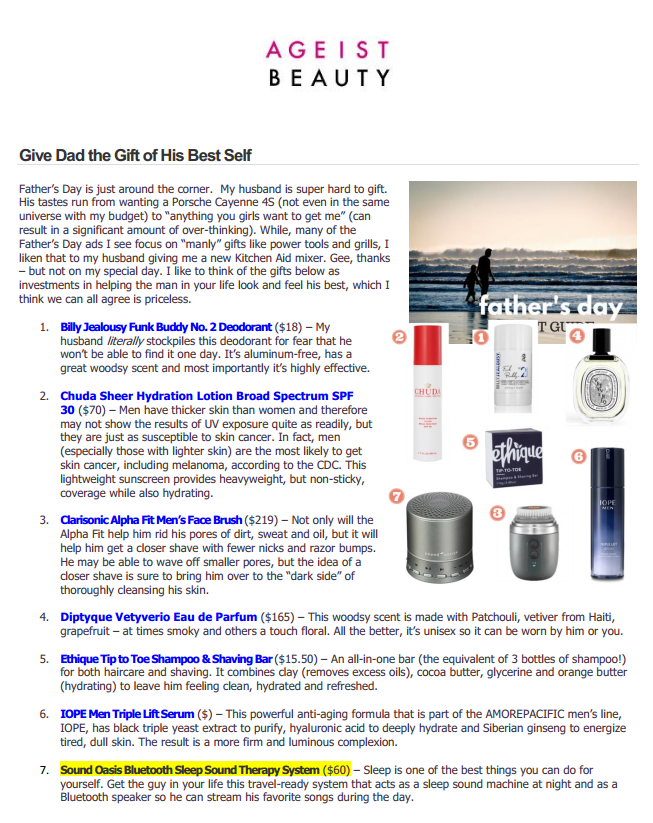
Forbes: Great Travel Gifts To Get Him - And Borrow Yourself
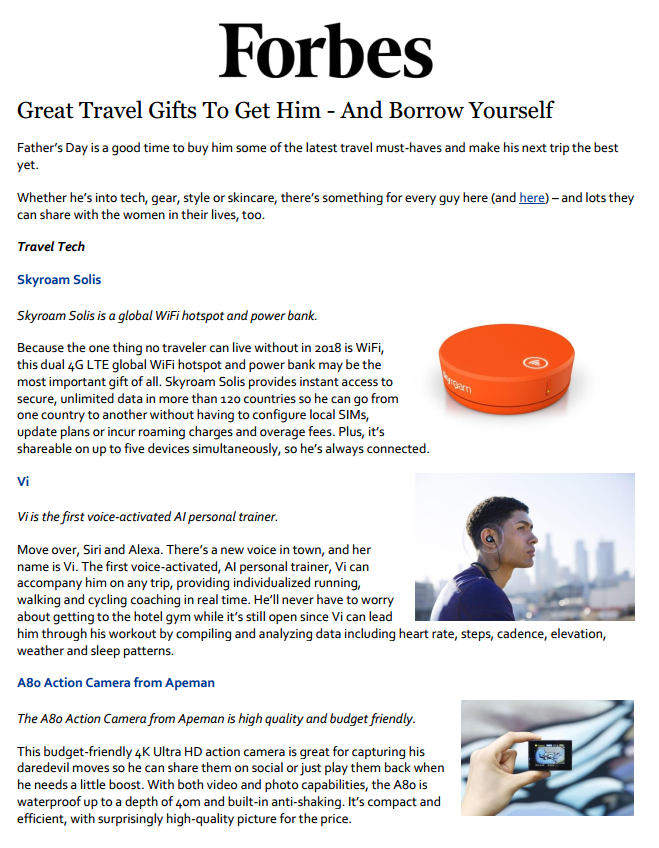
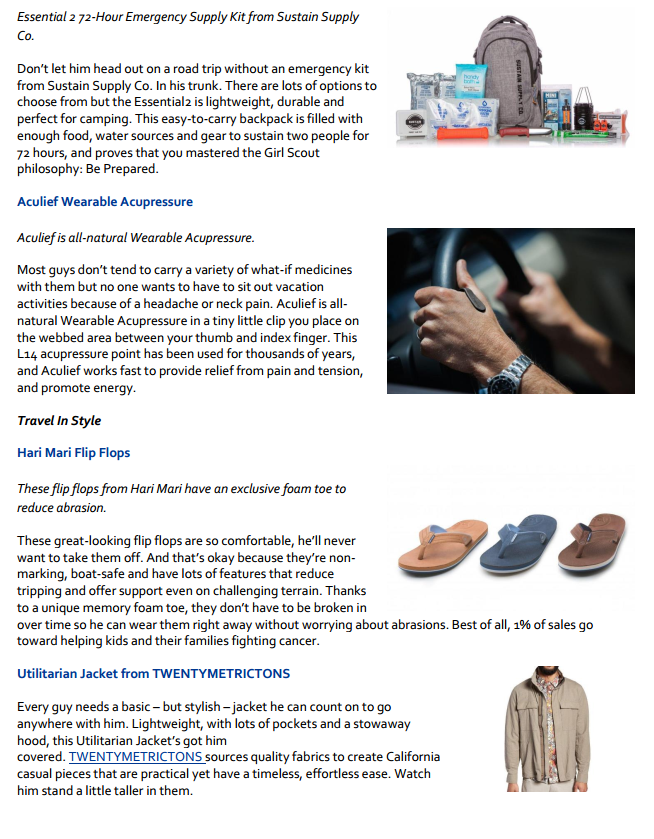
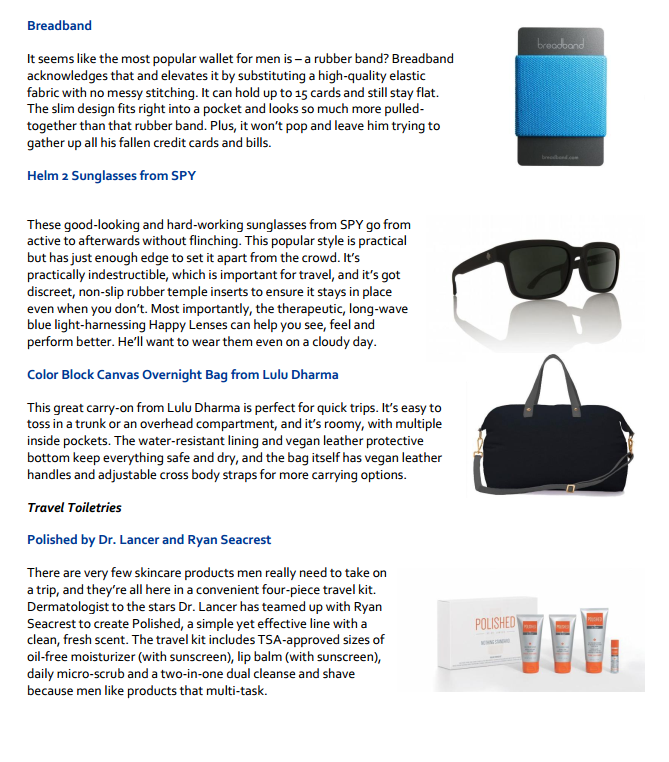

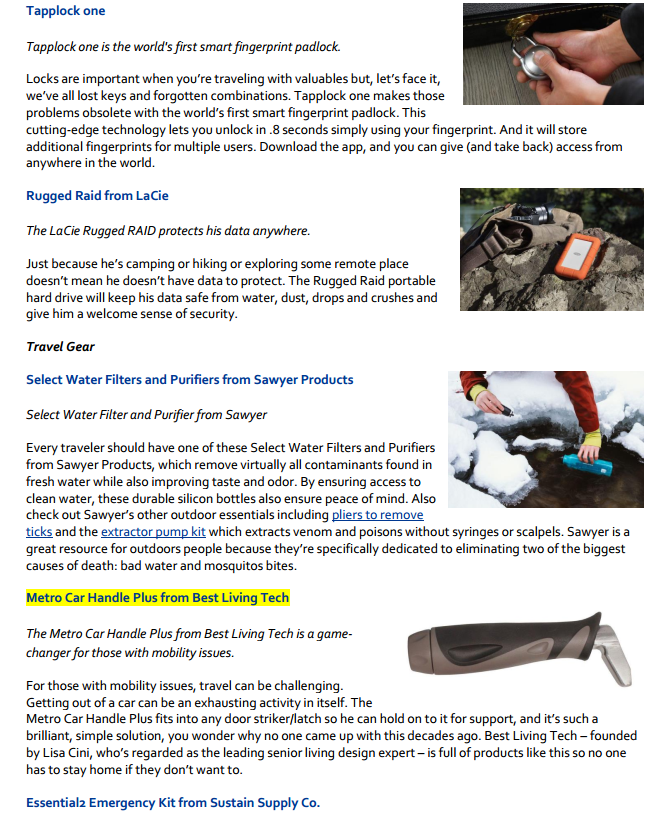
Find the entire article on Forbes website here.

The Dementia Caretaker’s Dilemma: Sleeplessness and Our Family’s Solution
By Lisa M. Cini
We all know how miserable life can be without a good night’s sleep. Sleep is especially important when there’s a lack of sunshine. Given how much time we spend inside during the winter (up to 90% of our day some studies say), we could all use more sunshine and/or shuteye. Sunshine kicks off our circadian rhythm which is what sets our body clock to enable us to sleep well at night. When we don’t have enough sun or sleep, we can feel depressed, anxious, excessively tired or irritable. I’m sure your family can elaborate on that the last one if you’ve ever been really sleep deprived.
The reality in my house right now is this – a colicky baby, only 100 times worse. How is that possible you say? Well, the 5’6”, 135 lb. sleepless woman I’m speaking of can’t hear very well and has dementia. My normally beautiful and pleasant 96-year-old grandmother lives with me, and right now, she isn’t sleeping.
Our house, in which lives myself, my husband, two kids, my parents, and my grandmother has become like the Russian sleep experiment in the 1940’s where they see how long you can stay awake before going crazy. Its 11pm and my grandmother been up for almost 62 hours. She thinks we are lying to her about her grandsons, who are in actuality my brothers; she keeps telling me that something is horribly wrong with them and pleads with me to tell her. I’m worn out, my husband is exhausted, my parents are teetering on sleep deprived and my beautiful, kind, classy grandmother has become a mean, paranoid, delusional night walker.
This isn’t the typical sundowning episode that causes many people’s dementia symptoms to worsen with decreased light in the afternoon or evening. This is new, 3-day night walking event is the third since Thanksgiving.
Things run pretty smooth and my mother is the primary caregiver for my grandmother.
Before these episodes began, things ran pretty smoothly with my mother as the primary caregiver for my grandmother. However, in the last few months, things have become sad and extremely challenging for everyone in our house. I never imagined that I would consider sending my grandmother to a memory care home, especially one in the price range we could afford; but, during this third incident, the thought more than just crossed my mind.
I keep thinking of my grandma and reminding myself how wonderful she has always been to all of us. It’s particularly tough to witness what seems like some evil that has taken over her body. At this point I’ll do just about anything to get my grandmother or our lives back.
Enter, the MIRACLE. Recently, I attended a futurist tech conference in LA and was introduced to a gadget that helped our family go from being an Agatha Christy novel with people scheming how to get rid of grandma (to put your mind at ease, no murder was ever spoken about), to being a story of divine intervention, where the clouds of confusion, paranoia and irritation were lifted and best of all, we all returned to sleeping 8 hours per night.
This fairy-tale gadget looks like an Ipod with ear buds. Instead of music though, light is pulsed for 12 minutes into the ear and reaches the skull. This kicks off the circadian cycle and resets the body clock promoting a normal sleep schedule.
The research behind this miracle device is so solid physicians have begun using it to treat seasonal affective disorder (SAD), jet lag and elite athletes with chronic sleep issues. While all those uses are impressive, nothing is more so than the fact that since we started using the device, my grandmother has slept through the night, every night!! This little light device has taken our lives from miserable to magical.
If you would like to learn more about how to sleep better or help someone you love to sleep better click here. My hope is that no one will ever have to experience what our family did this holiday and I’d bet you don’t have to with use of this simple tech gadget that can change life for the better.

5 Reasons for Older Adults to Update Their Tech Skills
Learning new technologies can be daunting, and at times may seem like more trouble than it’s worth. But as members of the Baby Boomer generation reach retirement age, there are plenty of good reasons to make sure they’re up to date on the latest technology.
The good news? It doesn’t have to be difficult. Scott Moody, who’s been developing technology specifically designed for seniors with the company he founded, K4Connect, disputes the common perception that older adults are uncomfortable with technology, and says he has the data to back it up.
“What they don't like is tech designed for 25-year-olds with bigger fonts,” Moody said. “I actually find that the premise that older adults don't like technology is the fault of the people designing the technology.”
K4Connect’s first product is a comprehensive software platform for senior living communities that allows community residents to turn on lights, adjust the heat in their apartment, lock doors, track their health and communicate with neighbors.
The platform integrates other technologies that would be difficult for older adults to install and learn individually, but collectively can be even more useful for them than for younger folks, Moody says.
Tech for independent living
Moody points out that a lot of products currently available might be marketed toward younger people, but could be even more useful for older adults and seniors. For example, a wireless doorbell and lock may be appealing for a younger, healthier person who just doesn’t want to get off the couch, but for an older adult with mobility issues, it could be crucial.
“That really provides utility, it's not just a matter of convenience,” Moody says. This type of technology could lower the risk of a fall or injury, for example. “The whole bevy of home automation products really provides a lot of demonstrable value to the people we serve,” he says.
Many of these kinds of “smart home” products don’t even represent a high-tech upgrade, and are easily available at hardware stores and drug stores.
Other convenience-centered technology solutions could be crucial to seniors as well. Delivery services like Instacart and Postmates may be appealing to people who don’t feel like going grocery shopping, but a boon for seniors who find it difficult or exhausting.
Ride-hailing services like Uber and Lyft can allow seniors to run errands even when they find driving difficult, and some designed specifically for seniors have even cropped up recently.
Keeping connected
Many older adults, particularly those with mobility issues, tend to become increasingly isolated from friends and family with age. Learning technology can offer way to stay connected even if they’re unable to leave the house as much, Moody says.
But, he points out, some of the prominent social media platforms like Facebook and Twitter aren’t necessarily useful for this kind of connection. “We're not trying to keep the older adults’ faces glued to the information all the time,” Moody said. “Digital connection fosters personal connection.”
For example, Moody says, in senior living communities, internal communication tools can help residents stay connected with each other on a local level. Also, if friends and family are unable to visit often, they can keep in touch via communication tools like video calls, so they’re not already up to date on what’s happening with their loved one when they are able to show up.
Such strong social engagements can help keep people happier and healthier. An active social life is important for happiness and “your happiness plays directly to your health,” Moody says.
Staying healthy
Lisa Cini, the owner of Mosaic Design Studio, which designs senior living community interiors, points out that technology can also be useful in tracking health data, which is great for younger people trying to keep track of their exercise, but even more important later in life.
Apps for smart phones and connected watches that track baseline health data have become more popular in recent years, which can help seniors keep an eye on their health data or give them a nudge to stay in shape, Cini said.
“The main device I recommend is an FDA-approved EKG monitor that pairs with your smart phone to give you insights on heart health – this is a literal lifesaver in that it can predict an impending heart attack,” she says.
Another new device available is a sugar monitor, which can be helpful for making better dietary choices, particularly for those who may have a chronic condition like diabetes that necessitates strict diet.
New opportunities
Qi'Anne Knox, who tutors through the Varsity Tutors platform, says that with a little help, older adults can start whole new careers in technology. The Varsity Learning platform is an interactive application that allows enrollees to share work with tutors and chat over video.
Knox says she tutored one Baby Boomer named Mark, who left the U.S. Marine Corps after 17 years to pursue a new position as an engineer with AT&T. But he found himself at a technical disadvantage in his new job and lacked the skills, particularly computer programming skills, that would be necessary to advance.
He was a quick study, Knox says. “Mark was amazed by the things he could accomplish with technology and truly enjoyed learning new skills,” she said. “With every assignment, Mark became more confident in his work and was excited to share it with others.”
While she doesn’t think that everyone needs to learn computer programming in their work, keeping up on tech skills is important to compete in today’s work environment. Knox emphasizes the importance of mastering operating systems and basic professional software like Microsoft Office.
Lifelong learning
Continuing education doesn’t have to be about professional advancement, though. In fact, lifelong learning in itself can be hugely beneficial for older adults: keeping their minds active can help them stay healthy.
Furthermore, knowledge of the world can help keep older adults more confident and functional with age, Cini points out.
“I highly recommend podcasts and blogs as an easy means of checking in on the latest and greatest or learning about a particular topic that you encountered and found confusing,” she says.

Senior tech, at your service?
As the growing shortage of personnel to work in nursing homes and home care becomes more real, the new mantra of the longevity economy is that technology will be an acceptable substitute. Is there a solution that fits the needs and preferences across all our current age cohorts; Boomers, the Silent Generation and the remaining Greatest Generation? Never before in history have there been three generations over 60 alive and still kicking it. The cloak of AI wizardry is supposed to cover the needs of all seniors staying in their own homes as well as those in assisted living and skilled care. Especially for the boomer generation the beat is supposed to go on one new technology addition at a time. Listening to the patronizing approach of these entrepreneurs can become very annoying.
In my research for the week, I ran across a quote I would like to dissect. “Technology is the new assisted living,” says Lisa Cini. Cini, has been designing assisted living facilities for some 25 years. Her book is coming out this week: BOOM: The Baby Boomers Guide to Leveraging Technology. The book is advertised as how to save 40,000 to 120,000 dollars a year by tech-ing up instead of moving to assisted living.
It would seem she is a bit cross wise of herself as the main part of her resume is designing spaces for senior living, long-term care, and health care institutions. I guess there is only so much market for those luxury lofts with headed bidets. I am sure that the price point of these ideal senior spaces are already way off most people’s financial radar. And there is of course, a retail website that has all the usual suspects like pill organizers and amplification for the phone and basic assistive devices. The products on the website did help with my constant quest for t show me something I do not already know about. More later after I read and review the book.
So back to the question can technology well thought out and well placed keep people at home longer? Of course. If you are more tech oriented to start with, you can grow gently into even more sophisticated devices. If you reject technology and do not want to struggle with learning it you will be at an even bigger disadvantage. If having are okay with remote doctor visits, and you do not balk at having alarms and monitoring devices and your idea of a companion is 5 lbs of fur and wiring that purrs, then you have all that to look forward to.
Something is missing here. Get older, add tech, end up being monitored by your closest concerned relation from a distance or be dependent on the kindness and reliability of a local contracted service. Eighty percent of those over 60 are actually still living in their homes now and the surveys show eighty to ninety percent are hoping to stay at home. Add to that fact the demographics pointing to more than 46% of people over the age of 75 living alone in another decade. Yes, hopefully advancing technology will help us stay connected, feel safer and not get lost in the deadly wilderness of social isolation. But we will need more than sensors that tell what is going wrong or an artificial voice to tell us to keep our appointments.

AGING IN PLACE THROUGH TECHNOLOGY
Why and how technology is helping more people stay in their homes longer and age in place.
"Technology is the new assisted living," says Lisa Cini.
Cini, who has been designing assisted living facilities for some 25 years, is also the author of the forthcoming book, BOOM: The Baby Boomers Guide to Leveraging Technology, and founder of the retail website, Best Living Tech.
Through her firm, Mosaic Design Studio, Cini's mission is to create comfortable and functional spaces for senior living, long-term care, and health care institutions across the country.
But Cini acknowledges that most people would much prefer to age in place—living in their own home.
Indeed, according to Laurie Orlov, founder of Aging In Place Technology Watch, 80 percent of older adults today do live in their own homes, with one-third of those 65 and over and more than 46 percent of those 75 and older living alone.
The desire for independence and the sense of well-being that comes from living in familiar surroundings are driving forces in wanting to age in place, but safety and security issues are significant causes for concern, both for older adults and their family members.
To allay those fears and meet the needs of seniors and their caregivers, investment in the mature market is increasing, especially in the field of technology. The recent Consumer Electronics Show, sponsored by the Consumer Technology Association, featured senior-friendly technology, including
• Watches that offer a professionally-monitored personal emergency response system
• Wireless earbuds that evaluate the user's hearing
• Artificial intelligence platforms with such features as motion- and fall-detection
• Robots that can schedule and coordinate activities, such as family get-togethers, medical appointments and social activities
• Home security cameras with facial recognition software, so homeowners can create a gallery of trusted
visitors
• The Sleep Number 360™ smart bed from Sleep Number Corporation (NASDAQ:
SNBR), which gives a glimpse into the future of health and wellness by doing everything from identifying and warning of a heart
attack to detecting sleep apnea. The bed's biometric sleep tracking technology and comprehensive sleep database are laying the foundation for an effortless sleep and health platform.
“We envision a future where higher quality sleep transforms consumers' health and wellness," said Shelly Ibach, Sleep Number president and chief executive officer. “Sleep Number's 360 smart bed's robust SleepIQ technology platform integrates sleep science, sophisticated biometrics, and artificial intelligence to provide effortless adjustability and tangible improvements to their health."
Apps for caregivers can provide well-being updates, help manage care, and send alerts if the sensor picks up on changes in activity or eating patterns.
Innovation in senior-living technology is not stopping there. Research institutions like the MIT AgeLab and the Oregon Center for Aging & Technology are challenging technology developers and entrepreneurs to develop solutions and products that will transform the landscape of senior care.
Home monitoring devices and software, for example, will be able to relay your vital signs to your doctor. Skype will no longer just be a convenient way to see the grandkids, but will connect patients to their health care professional, helping them avoid an expensive or inconvenient office visit.
"Technology is giving us the confidence and security to remain in our homes as we age, which is what most of us want to do," says Cini.
Quality sleep will keep you performing your best. Like diet and exercise, sleep is essential for optimal health and performance. Because everyone's sleep needs are different, Sleep Number beds adjust to your ideal level of firmness, comfort and support, and have a 25-year limited warranty.** Find your Sleep Number® setting for your best possible night's sleep.
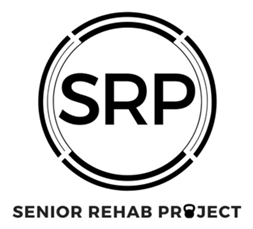
The Senior Rehab Podcast brings you helpful conversations for rehab clinicians that serve older adults. We speak with industry leaders & review the latest evidence to provide useful, practical information for
YOU - the rehab clinician. Join us in advancing rehab for older adults at http://SeniorRehabProject.com
How to DESIGN for Health, Independence, & Successful Aging w. Lisa Cini
How to DESIGN for Health, Independence, & Successful Aging
Ever wonder the WHY behind some of the spaces we inhabit? Wonder HOW those spaces can influence our quality of life?
Meet Lisa Cini, a Transformational Living Expert. She's helped create many facilities, building, and spaces with the goal of improving the quality of life of others. She has an amazing perspective that I know you will enjoy!
Pertinent Links:
• http://www.bestlivingtech.com/ (Use the coupon code: "rehab10")
• http://mosaicdesignstudio.com/about/lisa-m-cini/
• https://lisamcini.com/home

143: Lisa Cini – Designing for More than One Generation
Too often the elderly are shifted off to be someone else’s responsibility when they can no longer live on their own. Nursing homes, assisted living and memory care are popping up all over and frequent the news for abuses and lack of care. Not all are bad yet how do you decide the best course of action when a loved one can no longer be on their own?
My guest on this episode designs multigenerational spaces for families that choose to take care of three or more generations at home. She also designs spaces for facilities that care for the elderly, restaurants, sports teams and more. My favorite part– her four generation family is her test bed.
If you want to learn how to make multi-generational living work for your own loved ones, you will not want to miss this episode. Lisa shares successes, perils, pitfalls and a few things anyone can do to begin making a house work when you have older members in your home.
Lisa M. Cini is the Founder, President and CEO of Mosaic Design Studio. A global commercial design, project management and procurement company, Mosaic’s mission is to “Improve Quality of Life By Design.”
Lisa has the ability to take the complex and make it simple, as well as repeatable. By harnessing this ability, the award winning company has expanded 149% over the past three years.
Under Lisa’s leadership, Mosaic has dedicated itself to meeting clients’ needs, while upholding their mission, vision and values. She has helped a diverse clientele has meet with success on far-reaching projects, and among them are: The top global senior living operators, The United States Air Force, The United States Navy, the National Hockey League, Coopers Hawk Winery and The OhioHealth Hospital System.
Combining her business savvy with her wide-ranging creativity has brought Lisa into the publishing world. Her newest book, Hive: The Simple Guide to Multigenerational Living How Our Family Makes it Work is Lisa’s personal account of how her family has designed a home in which 4-
Generations live together and lead productive, happy and healthy lives, even as the eldest member of the family struggles with Alzheimer’s/Dementia. She just launched www.BestLivingTech.com in which she curates the best products to Embrace Living as we age. Think Sharper Image meets AARP!
Lisa is also the author of 2016’s THE FUTURE IS HERE: Senior Living Reimagined, as well as many articles. She has received numerous awards, which span multiple industries. A sought-after speaker, Lisa has been featured on radio and TV; recently, she appeared on Today in America with Terry Bradshaw.
This spring Lisa will release her 3rd book BOOM The Baby Boomers Guide to Leveraging Technology, so that You Can Preserve Your Independent Lifestyle & Thrive pre-release has already made #1 on Amazon Kindle in 4 countries!
Lisa is regarded as the leading Alzheimer’s and long-term care design expert in the nation, and has been recognized for her contributions in the field. Though appreciative of the recognition for her work, Lisa is most gratified by helping people who are struggling with Alzheimer’s, find ways to cope as individuals, as families, and as communities.
Lisa Cini has an enduring passion to learn from the best and create change where she sees the need, and when she’s applied this passion to the field of interior design, she has helped redefine it.
A resident of Columbus, Ohio, Lisa supports her community through her dedication to volunteer work. She believes that we are all here to add value to this world using our God-given talents and treasures.

Mother’s Day Gifts Guide 4! Such an appreciation of beauty and values! Such an ethical and responsible person!
Sharper Image meets AARP For boomer moms, mom in laws, grandmas and great grandmas:
Lisa Cini, award-winning, designer and founder of BestLivingTech: think Sharper Image meets AARP, searches the world for the best products to embrace living as we age and brings them all together for boomers. Here are her top picks for boomer moms, mom in laws, grandmas and great grandmas:
Companion cats, tabby and silver with white mitts and companion pup made by Hasbro, bring Joy, comfort, and companionship and fun for your elder loved ones. With realistic fur, purrs and meows – and sensors that respond to petting and hugs with familiar, cat-like actions – Companion Pets deliver a soothing, joyful experience that inspires smiles, laughter and fond memories for people of all ages.
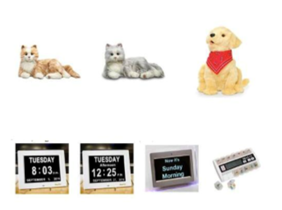
Simple LCD screens clearly display time, date, etc. with no abbreviations. Helps differentiate between day and night. Unique clocks are designed to help people living with Dementia or Early Stage Alzheimer’s, who often lose the ability to distinguish between days of the week and cycles of the day. It displays the Day of the Week along with either MORNING, AFTERNOON, EVENING or NIGHT.
Lisa helps baby boomers age at home, rather than in a home. Her 3 books are:
BOOM: The Baby Boomers Guide to Leveraging Technology, so that you can Preserve Your Independent Lifestyle & Thrive, The Future is Here: Senior Living Reimagined, Hive: The Simple Guide to Multigenerational Living is based on her social experiment of living in a 4-generation household and the positive impact design can have in a home for seniors with dementia.

Successful Multigenerational Living
Most of have heard our parents talk about the days when Grandma and Grandpa lived upstairs and young adults didn’t leave home until they married – some bringing their spouse back home again. In the post-war baby boom, it became fashionable to move away from the “old neighborhood” into the new houses being built in the suburbs. This left older people aging alone in cities while young people built their families in pretty neighborhoods with big yards and brand new schools.
Culturally, not a lot had changed since then – young people left home earlier, older people were aging in their own homes – until the financial crisis and recession of 2008. Then, for the first time in decades, the numbers of families living multi-generationally began to rise. And that continues. Each generation is adapting to life stage changes, like launching careers later for young people, taking care of older family members for people at middle age, and the desire to age in one’s own home for elders.
Lisa M. Cini wrote the book Hive: The Simple Guide to Multigenerational Living – How Our Family Makes It Work, in 2017, to describe her family’s journey to creating their own “hive.” So much more than a how-to, Cini takes us on the journey of conceiving, planning, building, and “doing life” as a four-generation family. She is an award-winning designer, with more than 25 years of experience designing for senior living. Still, she honestly admits she had much to learn in this process of designing their home, especially as her grandmother developed dementia early in the process.
The Simple Guide is full of practical tips for making this lifestyle work – from designing spaces to figuring out how to control the home’s thermostat to keep everyone happy. It is also filled with plenty of laugh-out-loud moments, like her city-bred husband’s decision to become a bee-keeper (a successful experiment) and then bringing home baby chicks to live in the guest suite.
Even vacations are family affairs, as the Cini’s traveled to Japan together when grandmother was 86. One of the trip highlights – the bidet seats on all of the toilets! When the multigenerational experiment was designed, Cini decided to put these toilet seats in all of the bathrooms. While the reasons were practical – allowing her grandmother older the dignity of taking care of her toileting and relieving her mom of that responsibility – the chapter is filled with anecdotes.
“I remember with absolute clarity (and delight) the first time my father, a combination of Robert De Niro and Archie Bunker, used his bidet seat. Since he did not exactly read the manual from cover to cover, he went in and a moment later came out screaming he had a ‘G.D. tornado up his A.’. . .I can honestly say, I am not sure why the setting ‘Vortex’ should ever be on one of these bidet toilet seats, but my father was the lucky one to try it out.”
Even if this lifestyle isn’t for your family, it is a glimpse into the future for many of us.
The humanity and intelligence in the pages of this guide provide beautiful, profound lessons of how to live fully at every age. My favorite – “Overuse I love you.”
About Lisa M. Cini – Lisa is an award-winning, an internationally recognized designer with twenty-five years of experience developing interiors for senior living communities. Her previous work, The Future is Here: Senior Living Reimagined is about technology that will change senior living. Her firm, Mosaic Design Studio, is the leading provider of design services for senior living and healthcare.
Mosaic Design Studio recognized for achieving Accredited Engaged Organization
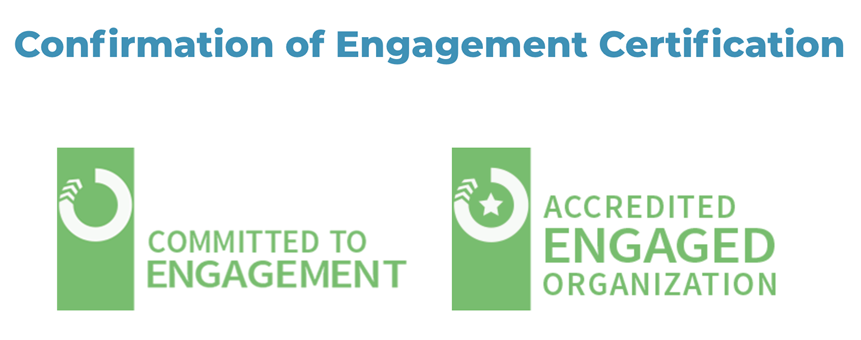
Technology should serve you as you age in place
Check out the latest interview in The Beacon Newspaper to hear the latest from Lisa, one of the nation’s experts on designing functional and comfortable spaces for senior living.
Full article can be found here.
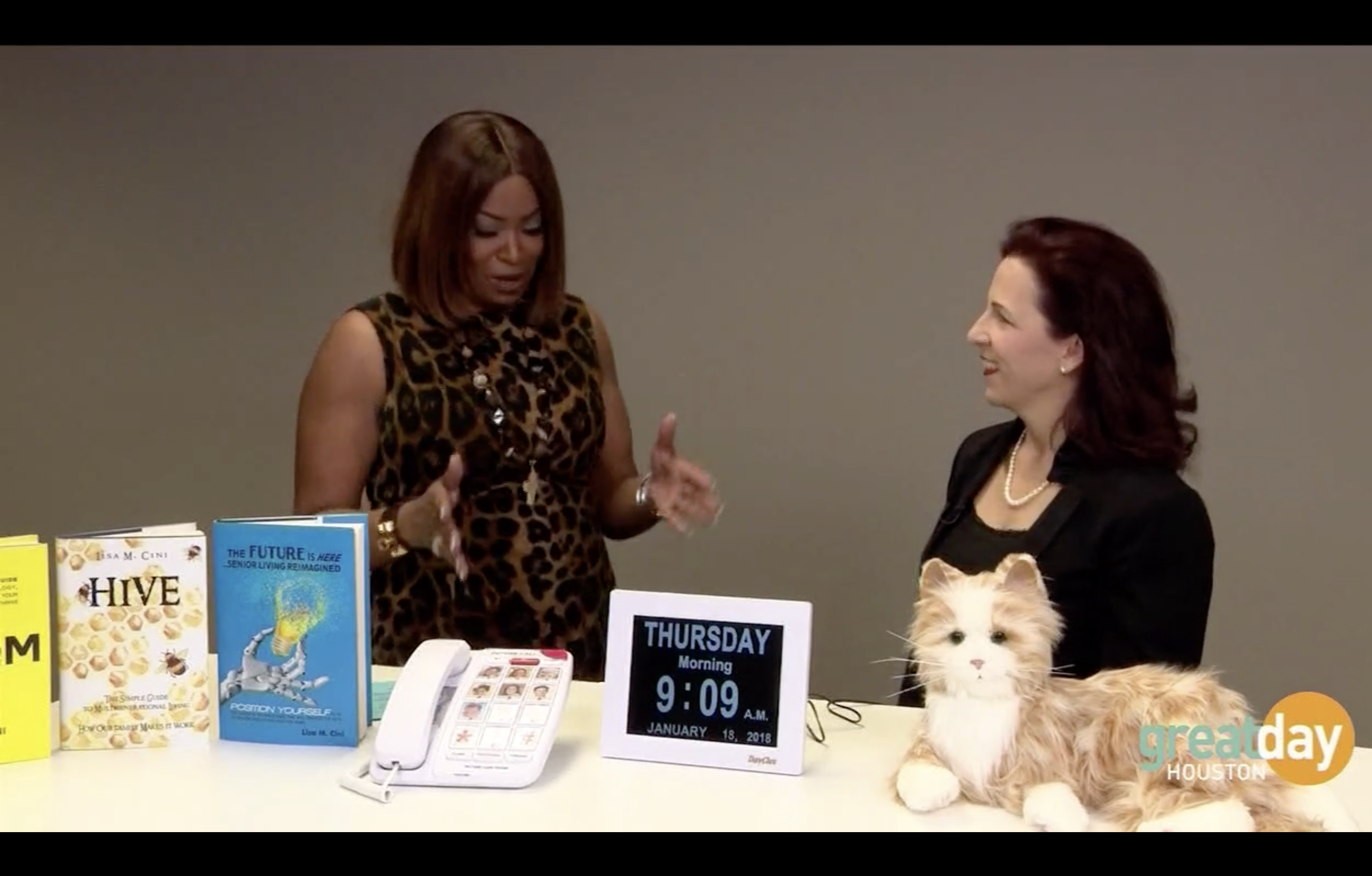
Tech for Baby Boomers on Great Day Houston
Check out Great Day Houston featuring Lisa sharing some innovative new products for baby boomers who want to age well at home. Click here to see the full video.
BOOM to Launch Today!
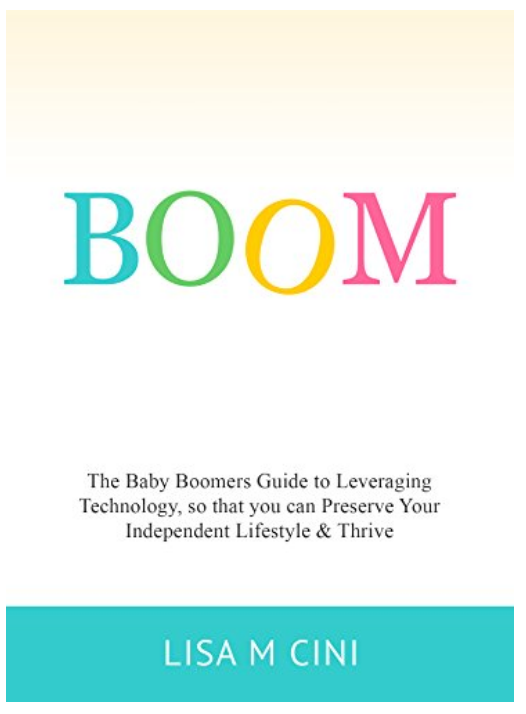
So excited for BOOM to launch today! Please help me out and pre-purchase the kindle version for 99 Cents.
Click here to check out BOOM!
What's Hot: Trends in the Pipeline for 2018
Fantastic interview with Lisa Cini on trends for the new year. Read more to find out what is coming up in 2018.
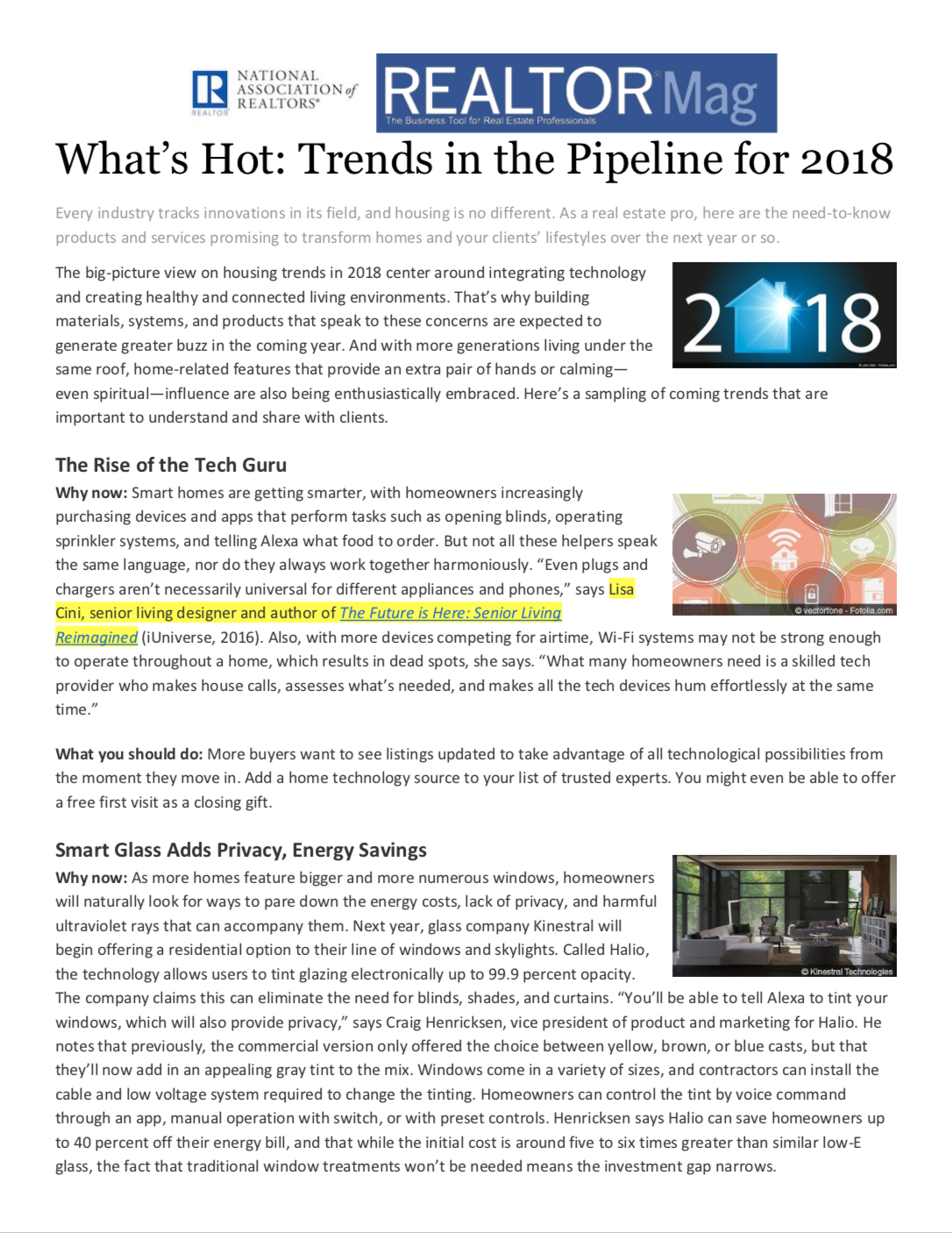
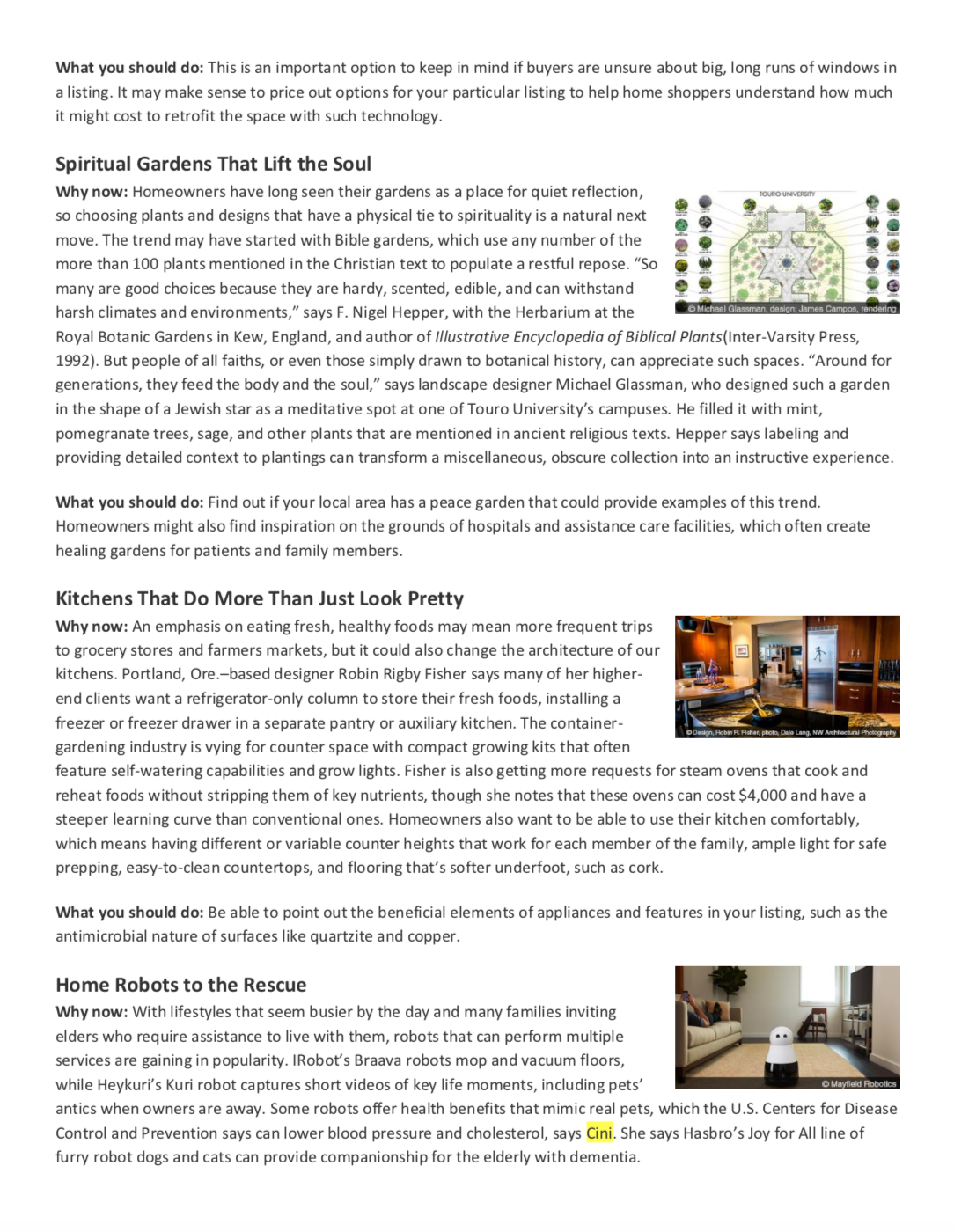
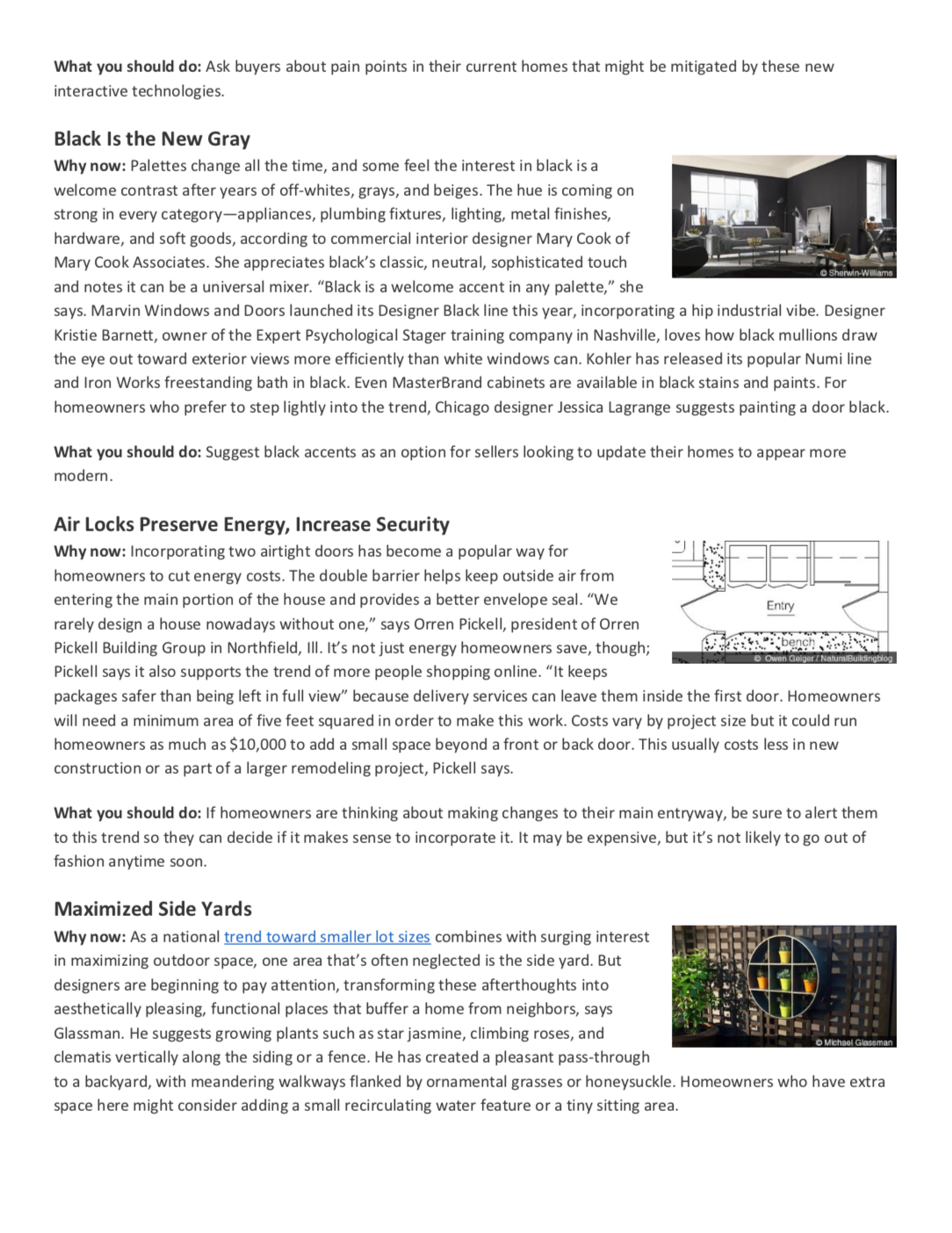
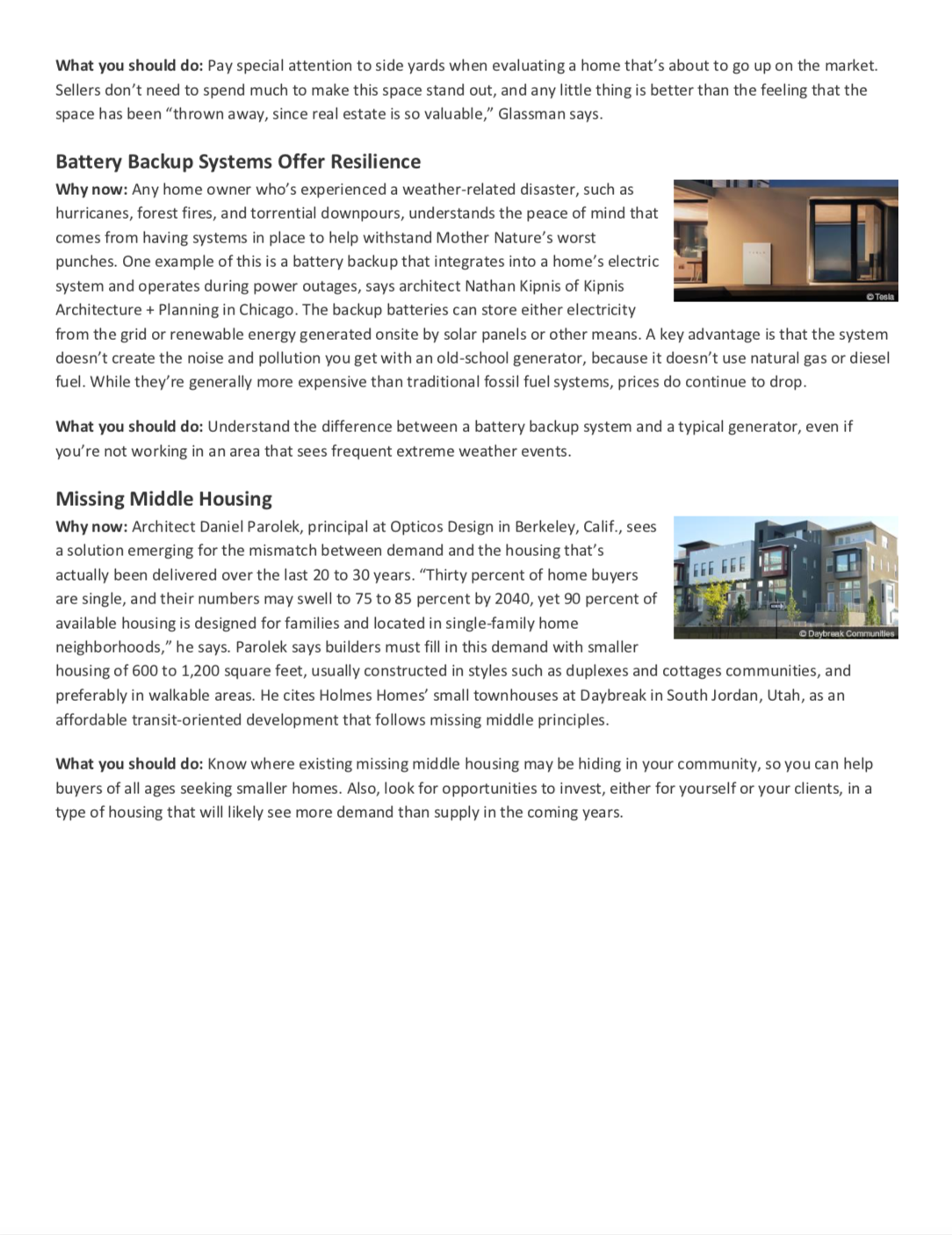
Full of Life at Vista Springs
Mosaic Design Studio has been featured in Properties Magazine, the leading Real Estate, Construction, and Architectural publication in Northeastern Ohio.
Check out the article and why Mosaic is the leading edge in senior living.
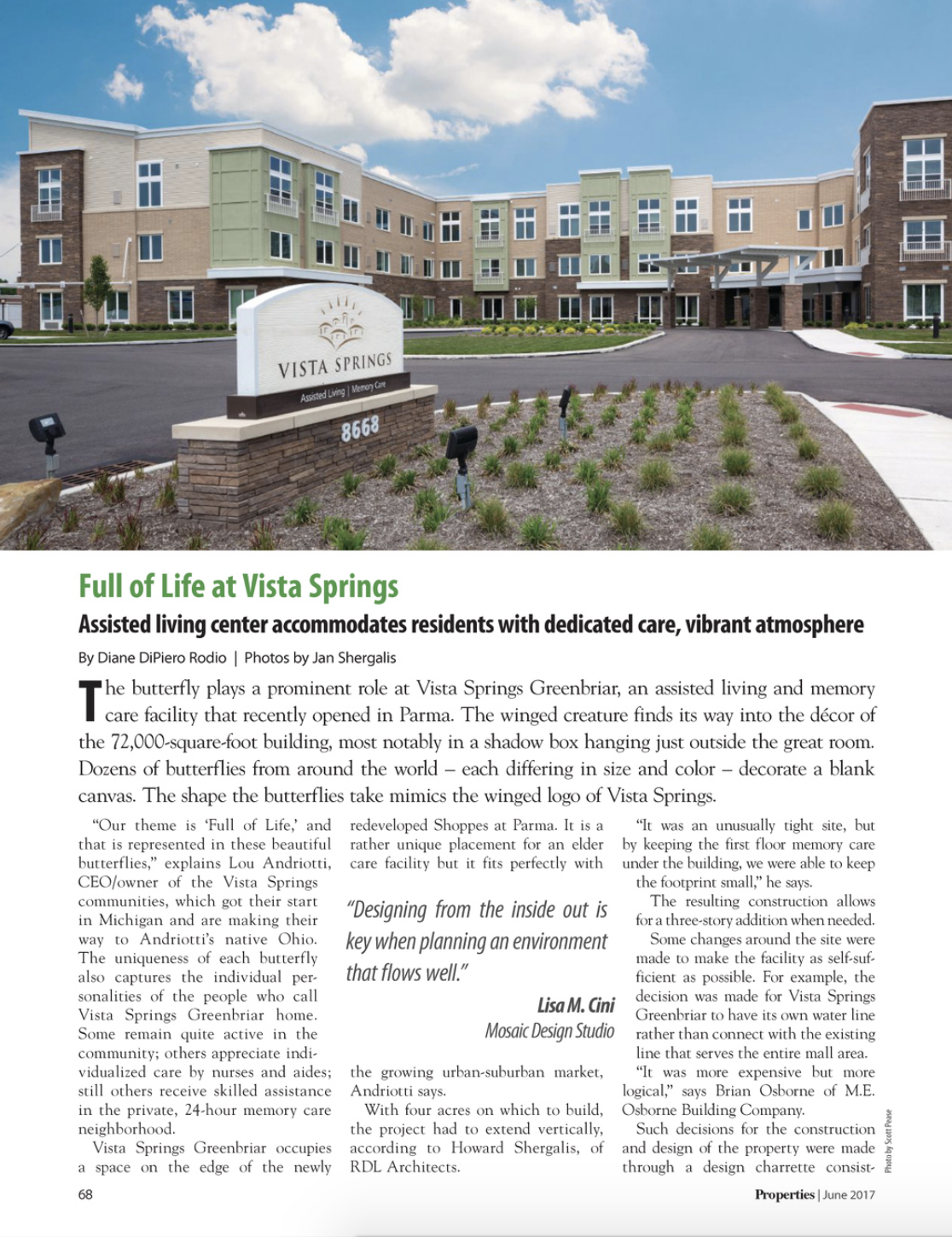
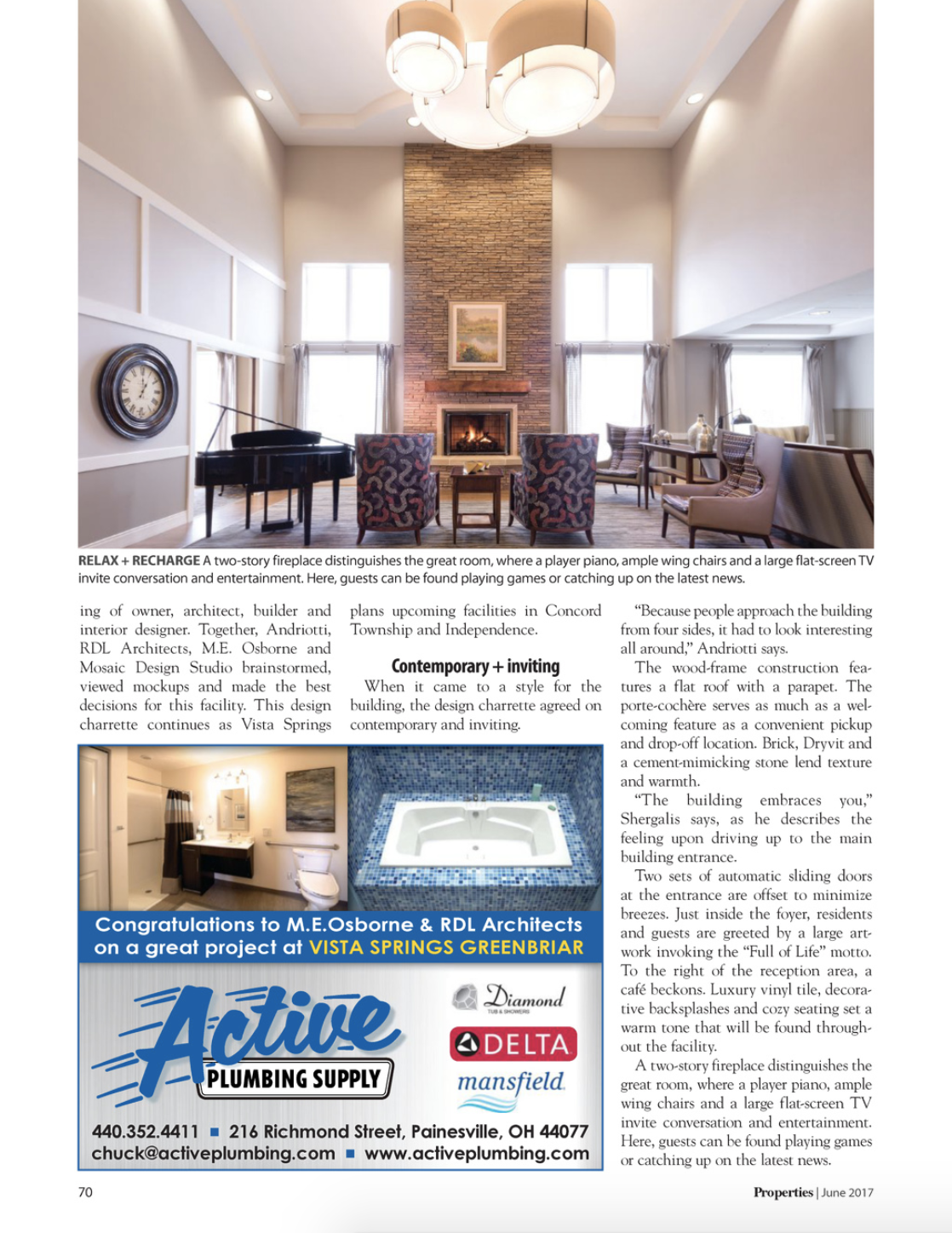
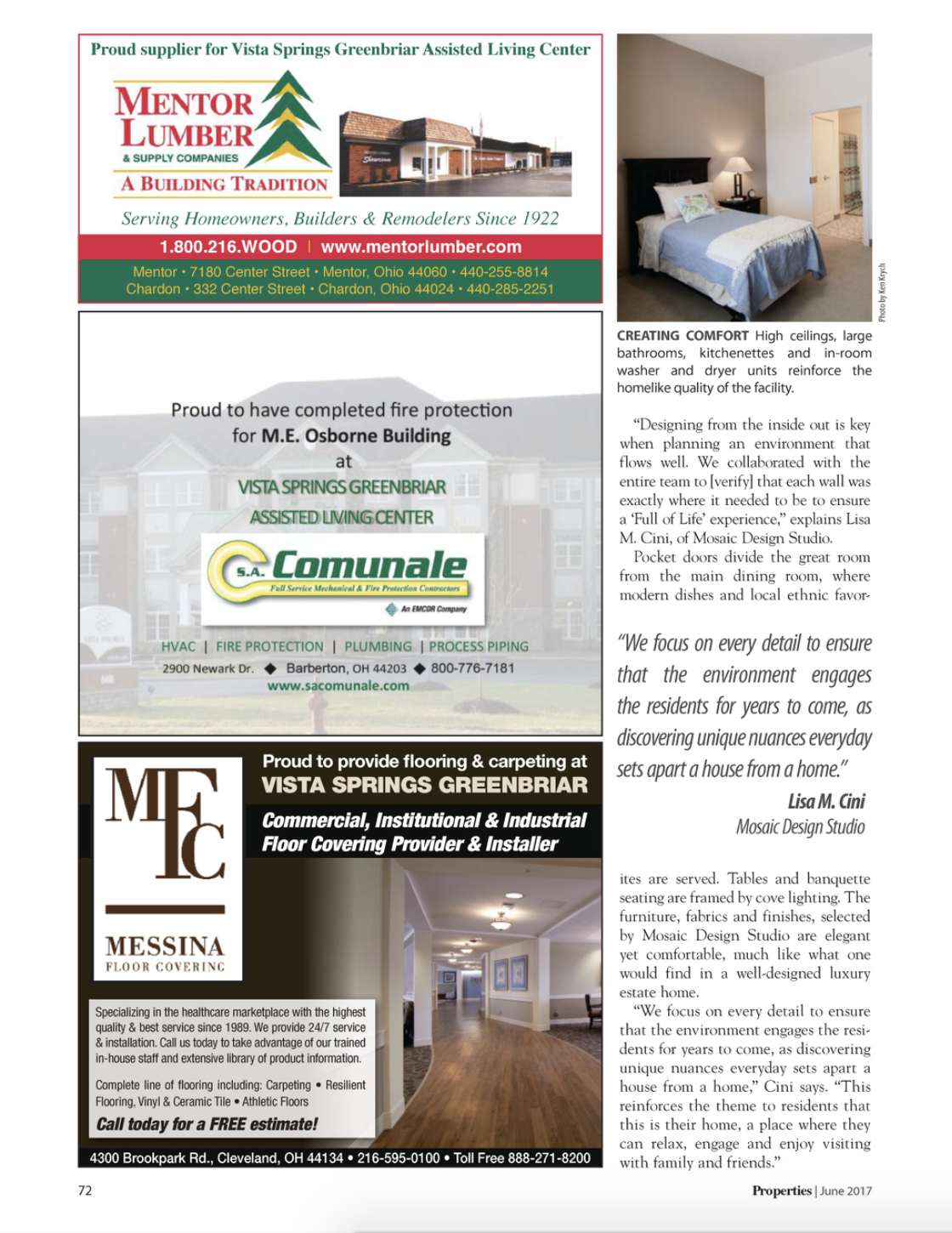
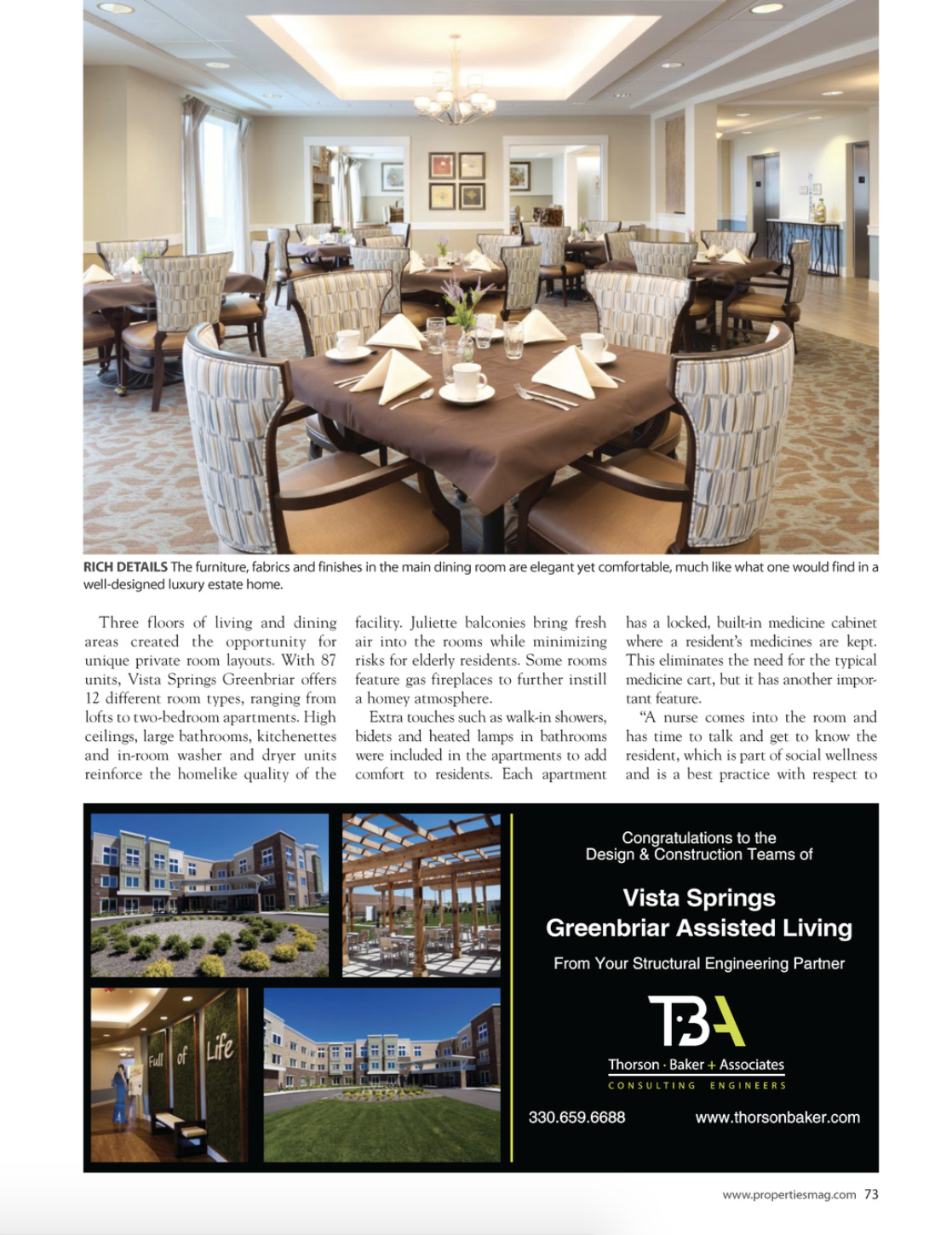
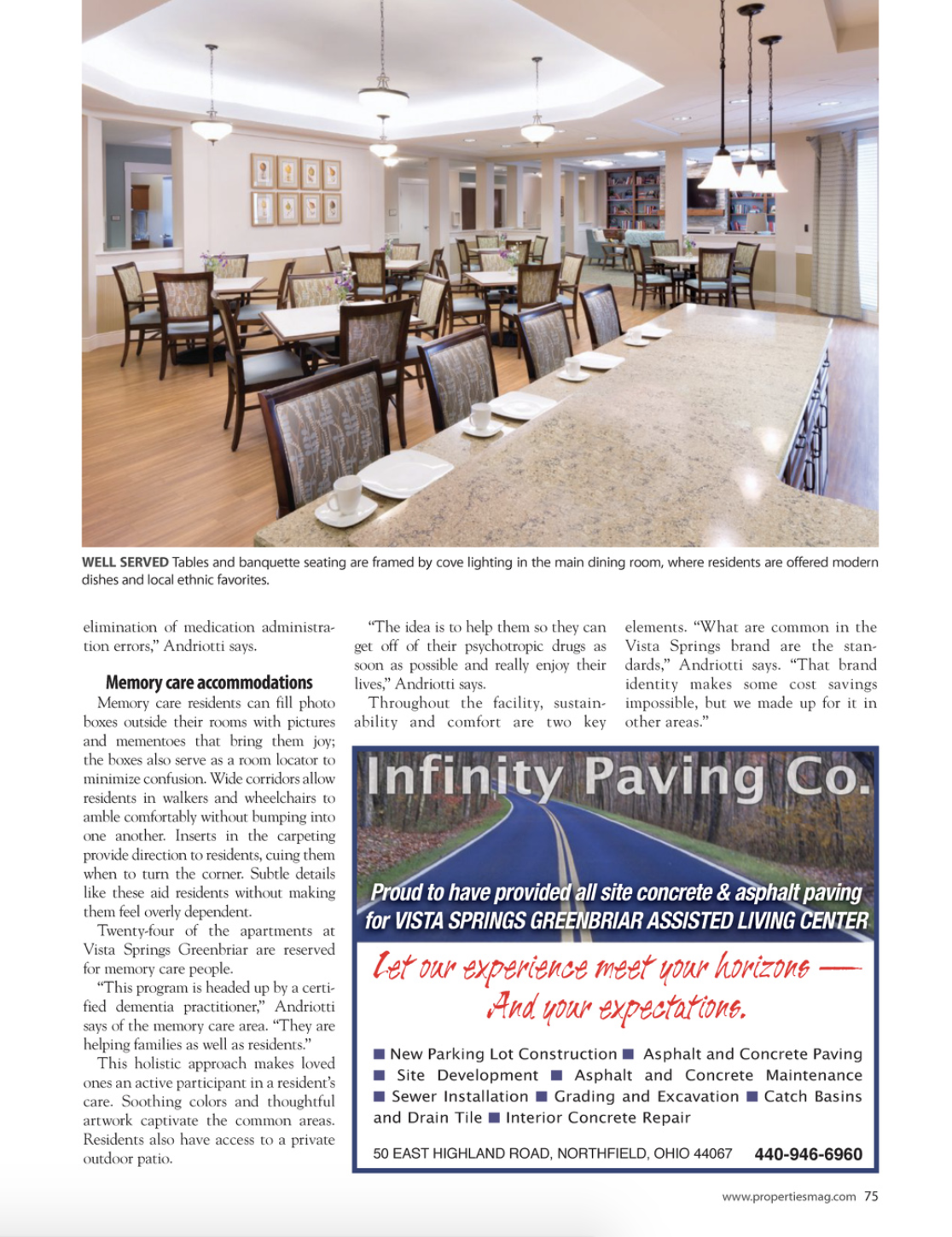

Life in the Hive: A Multigenerational Experiment at Home
Below is a can’t-miss article about Lisa sharing her life, her family and designing a home with every detail and family member in mind. Continue reading for an insightful journey through a life in the hive.
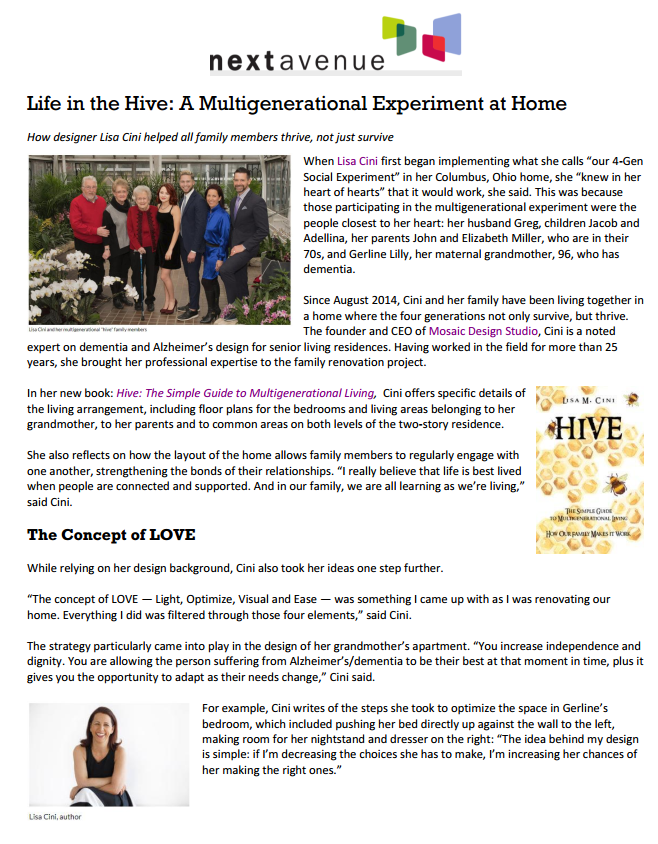
Neuroplasticity and its impact on senior living
